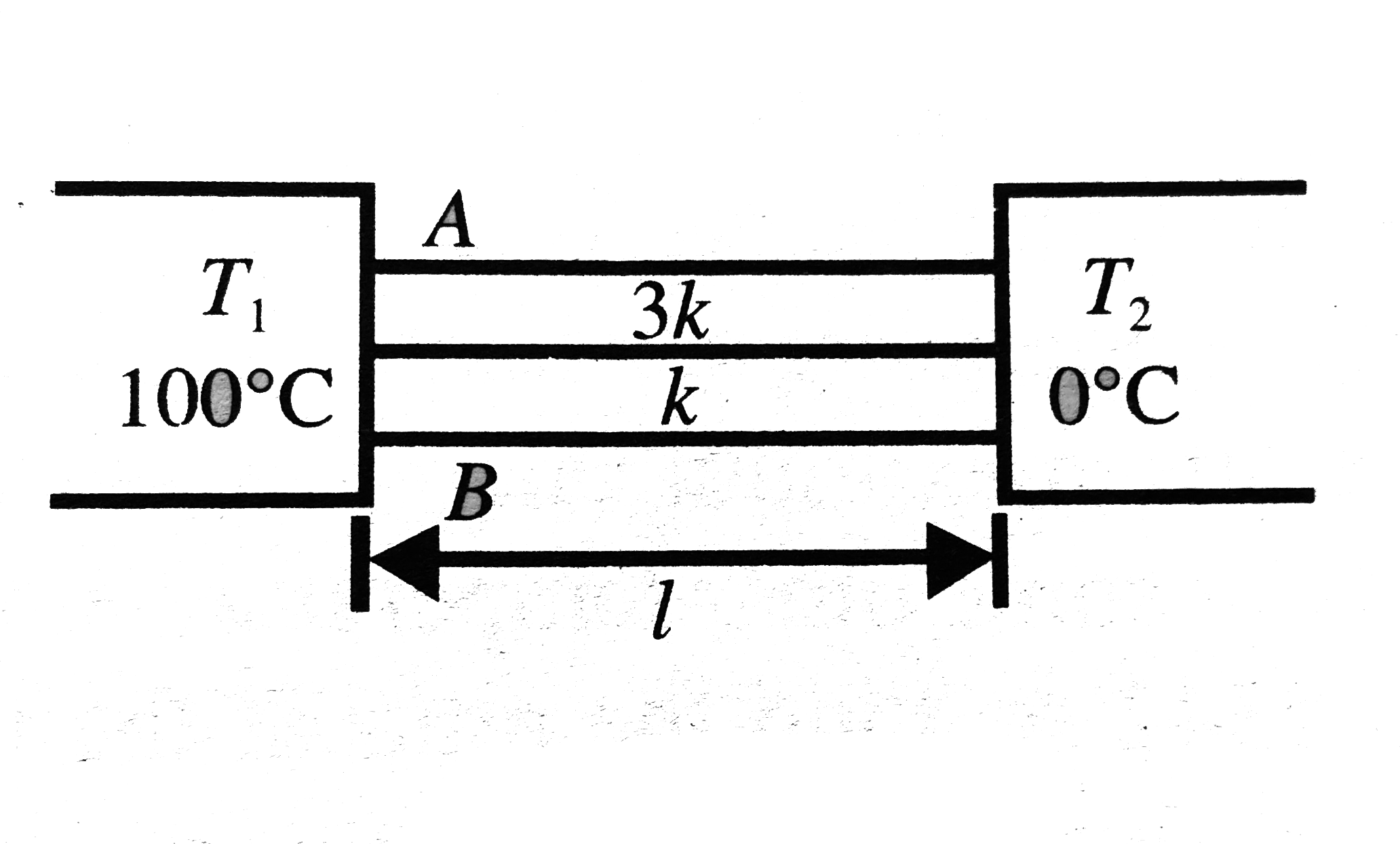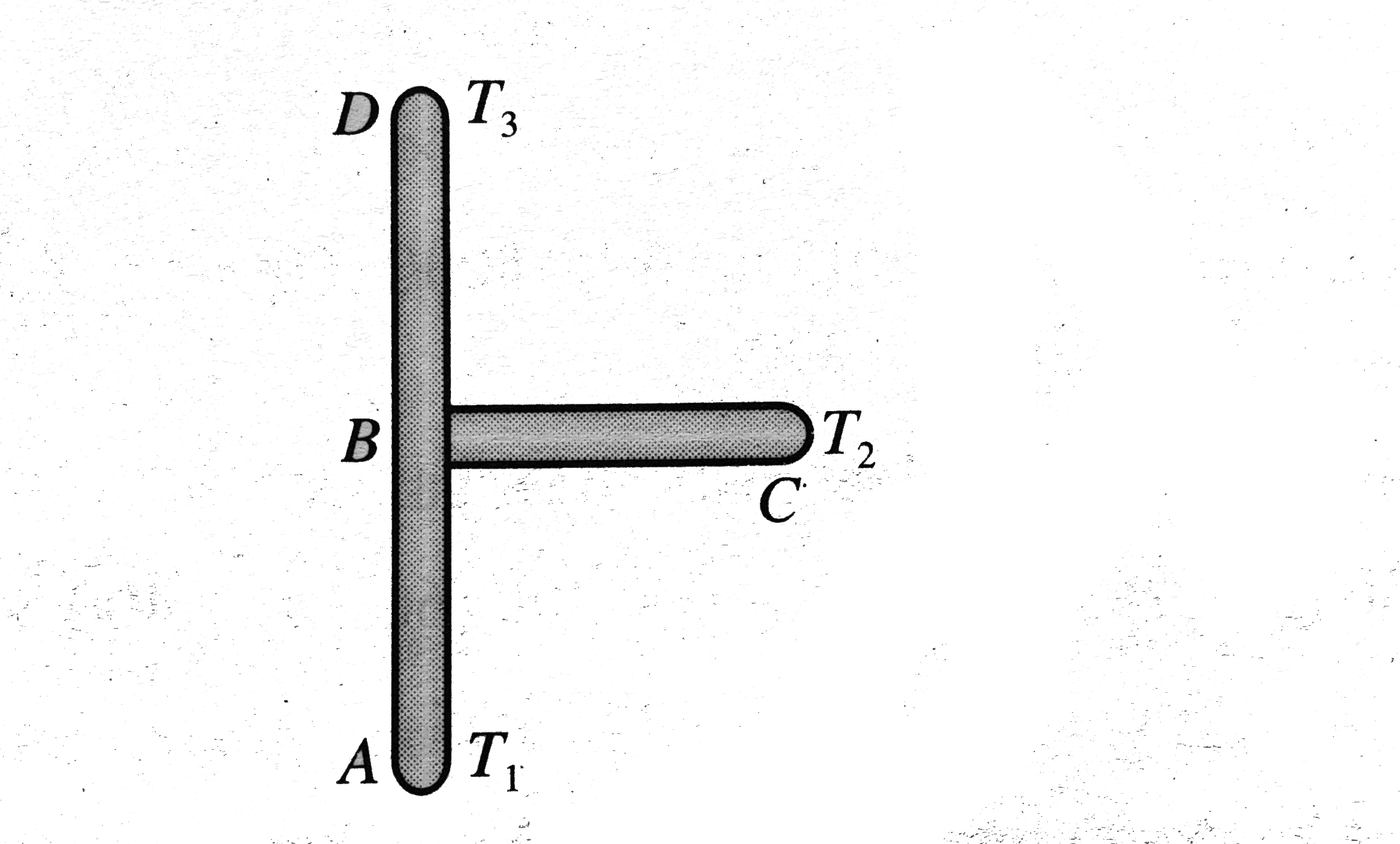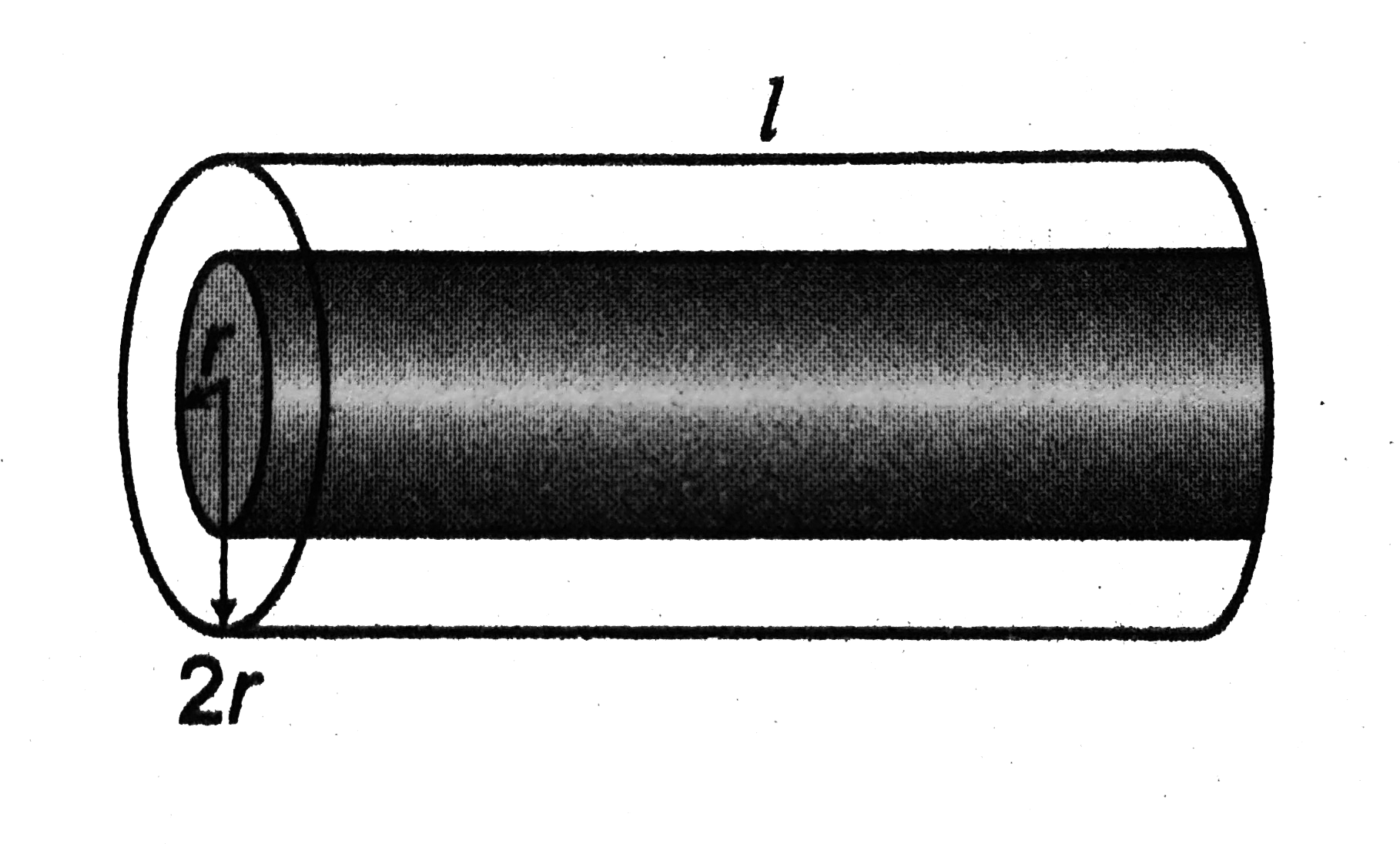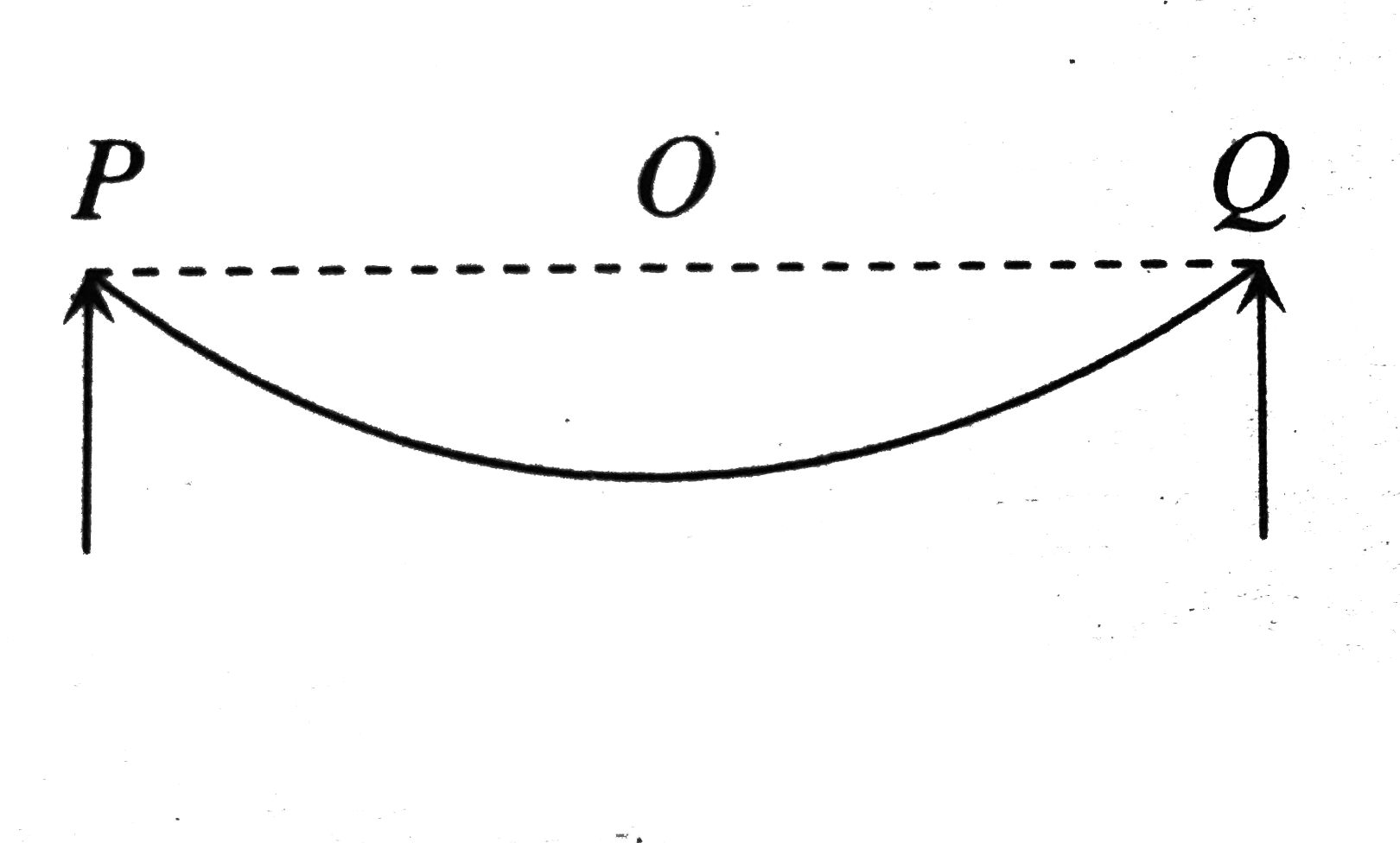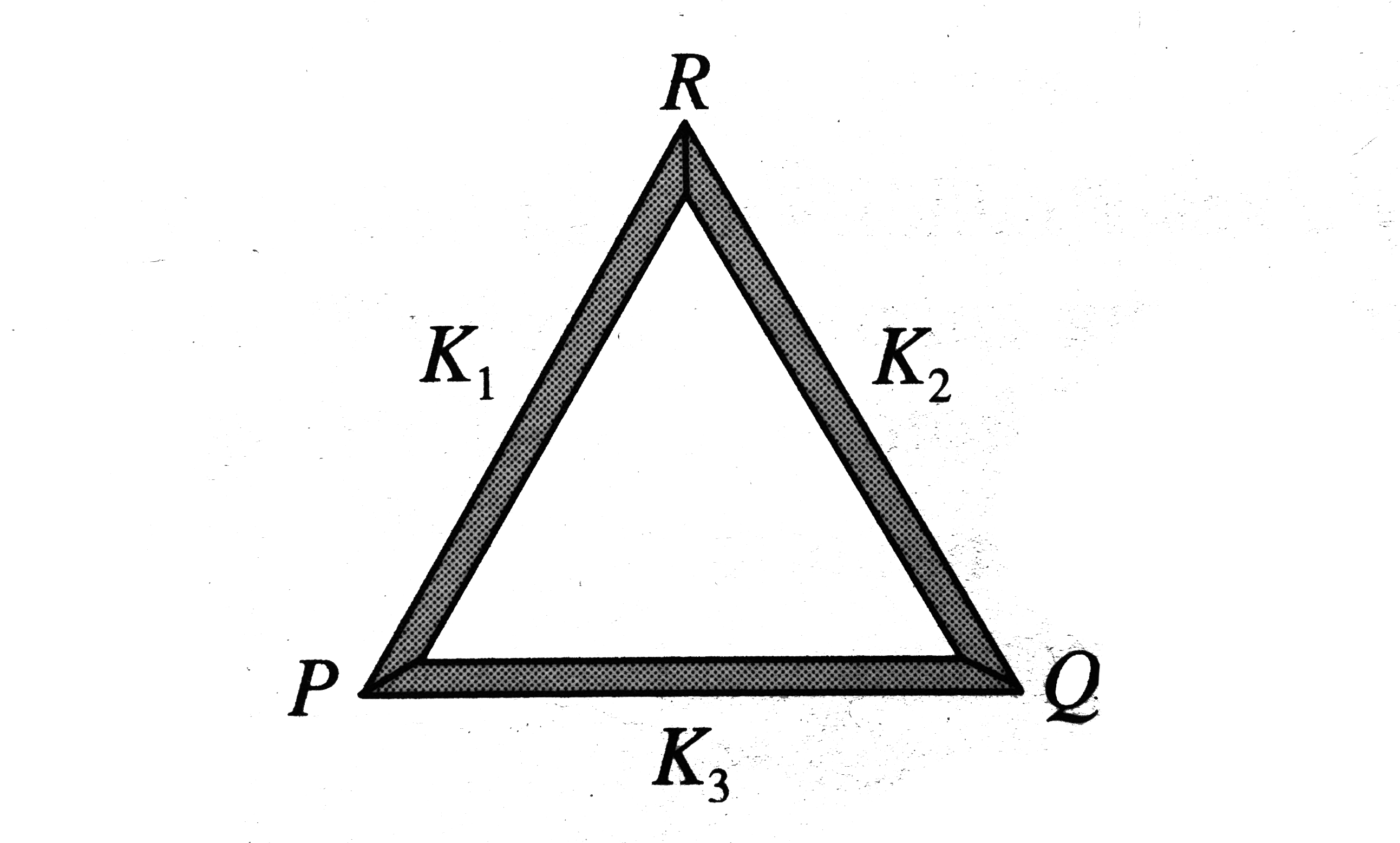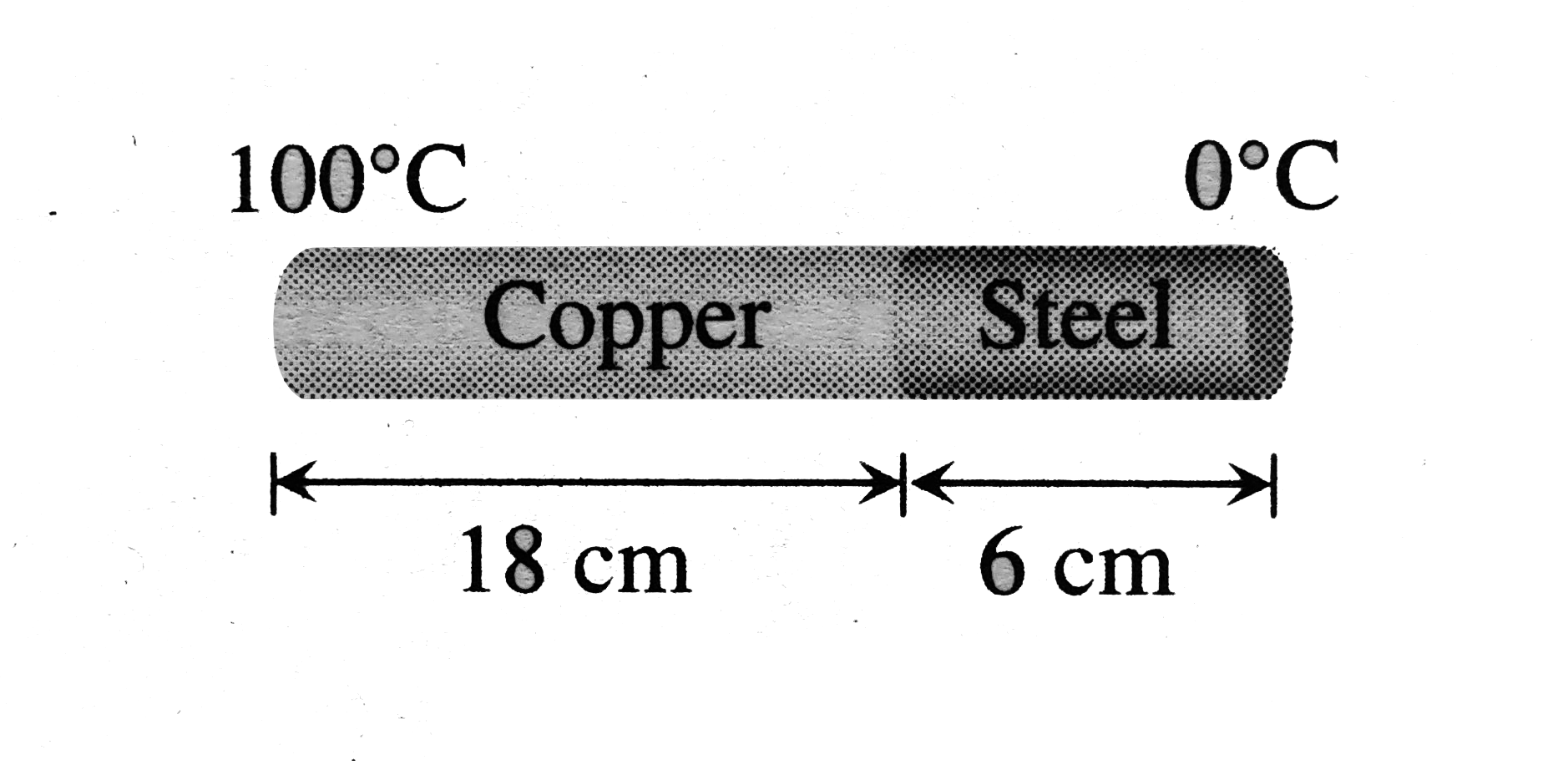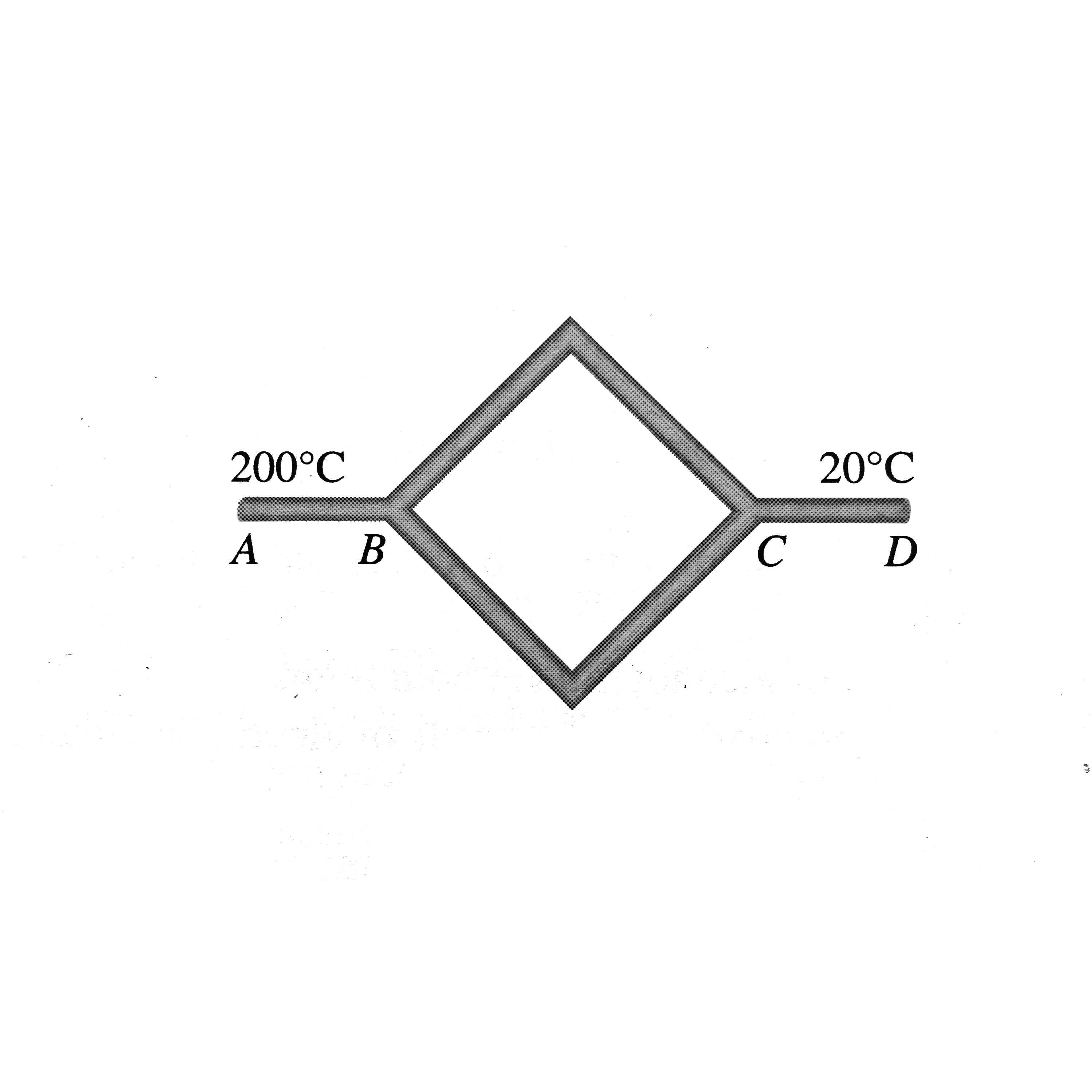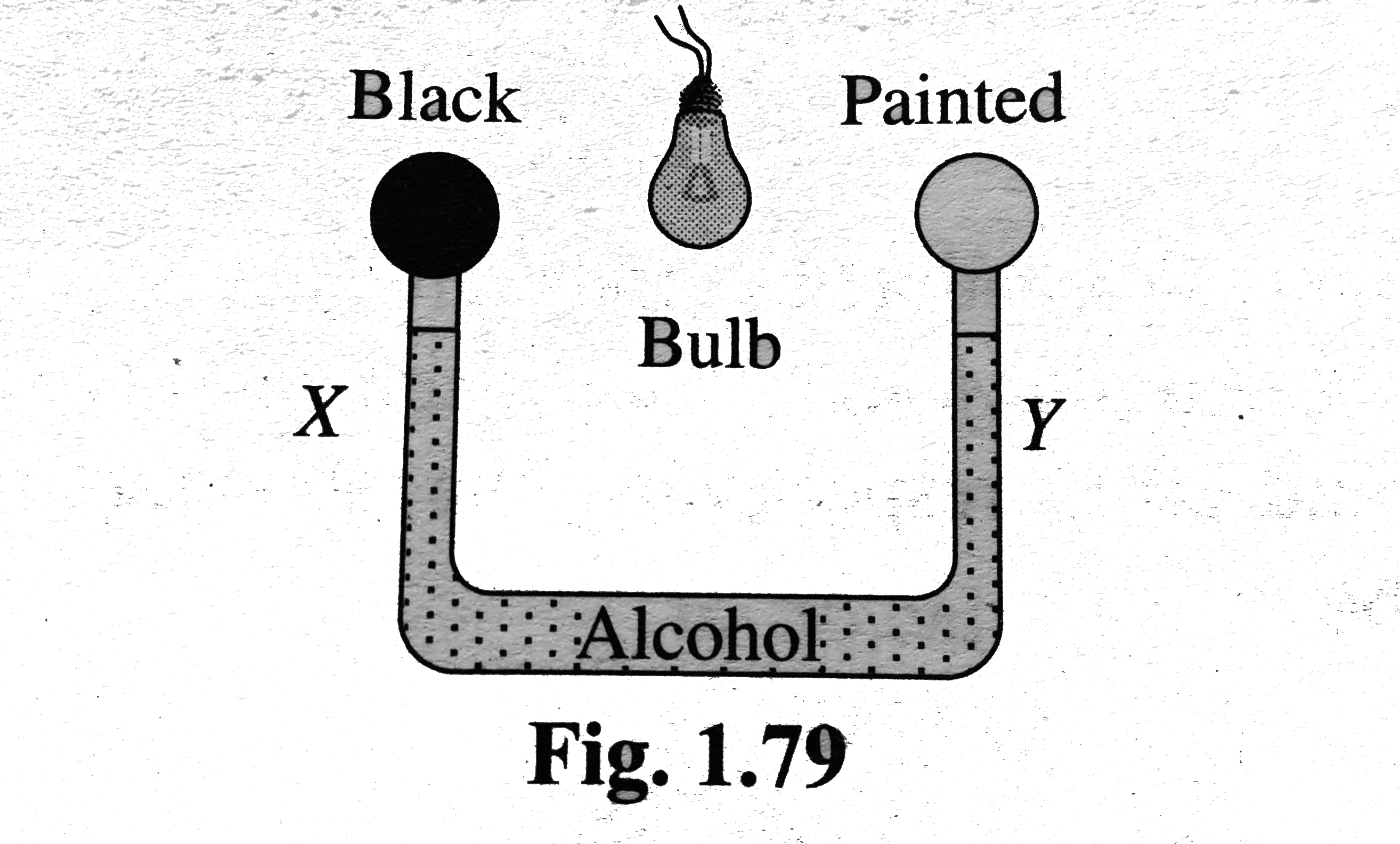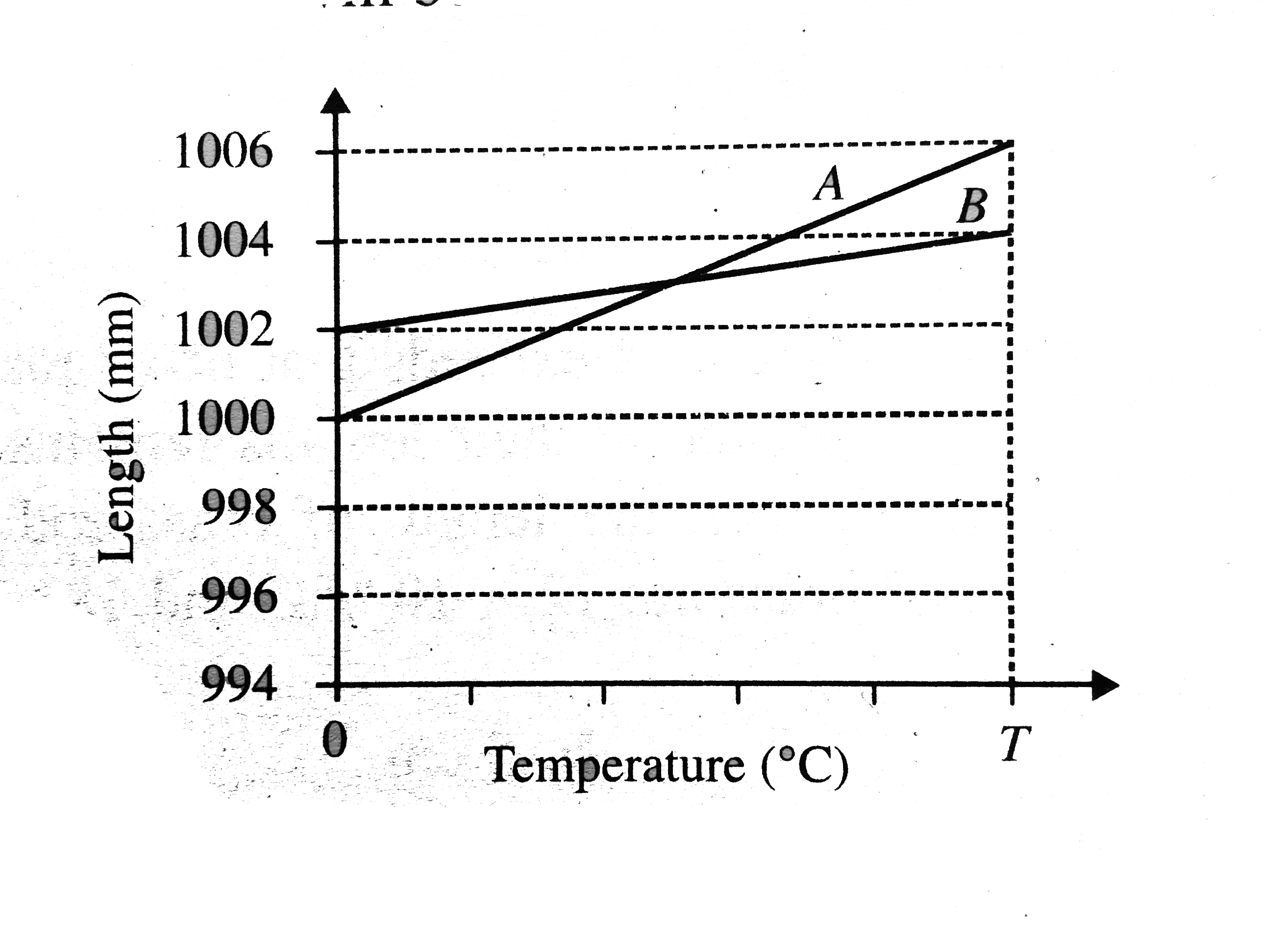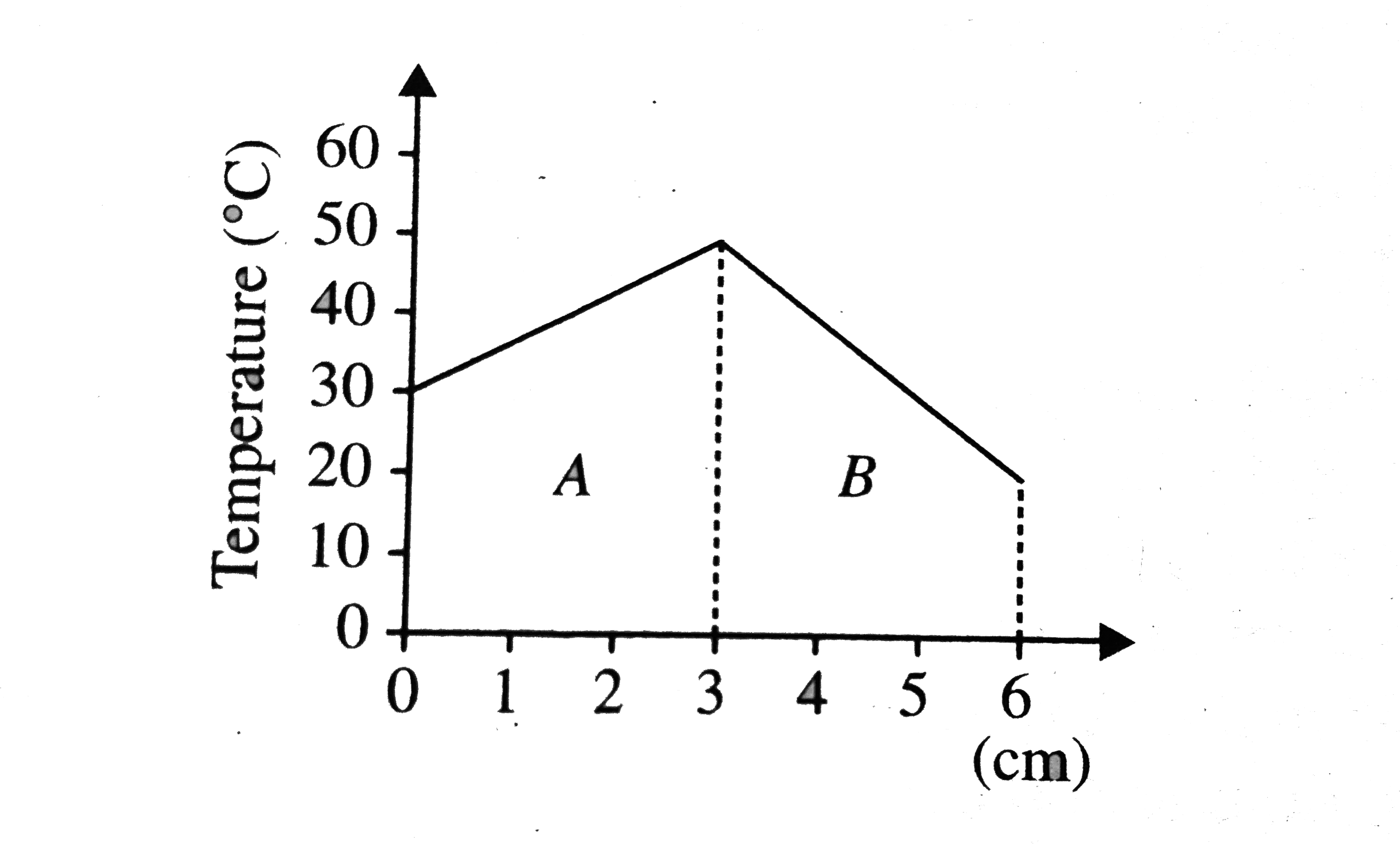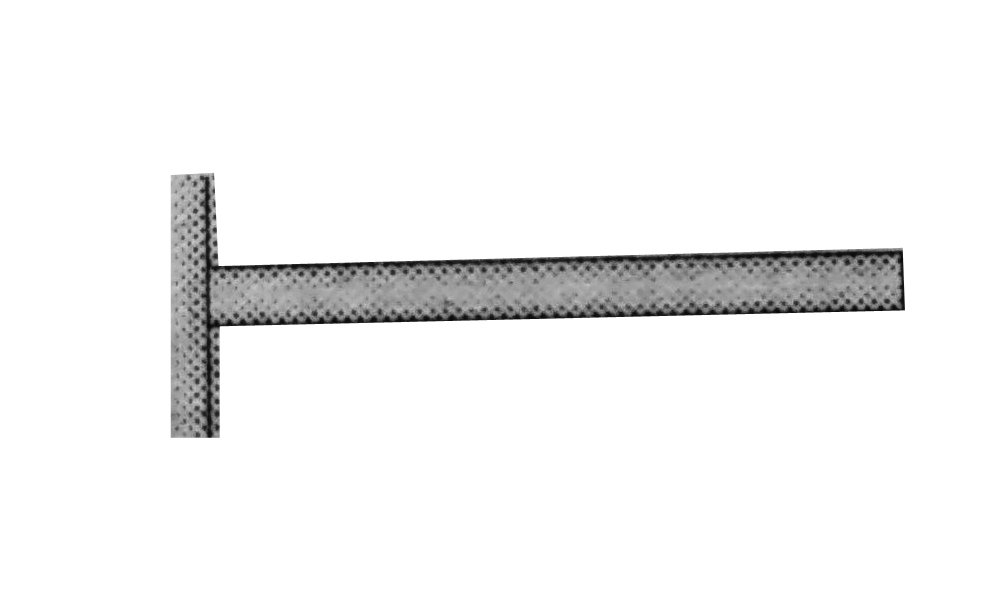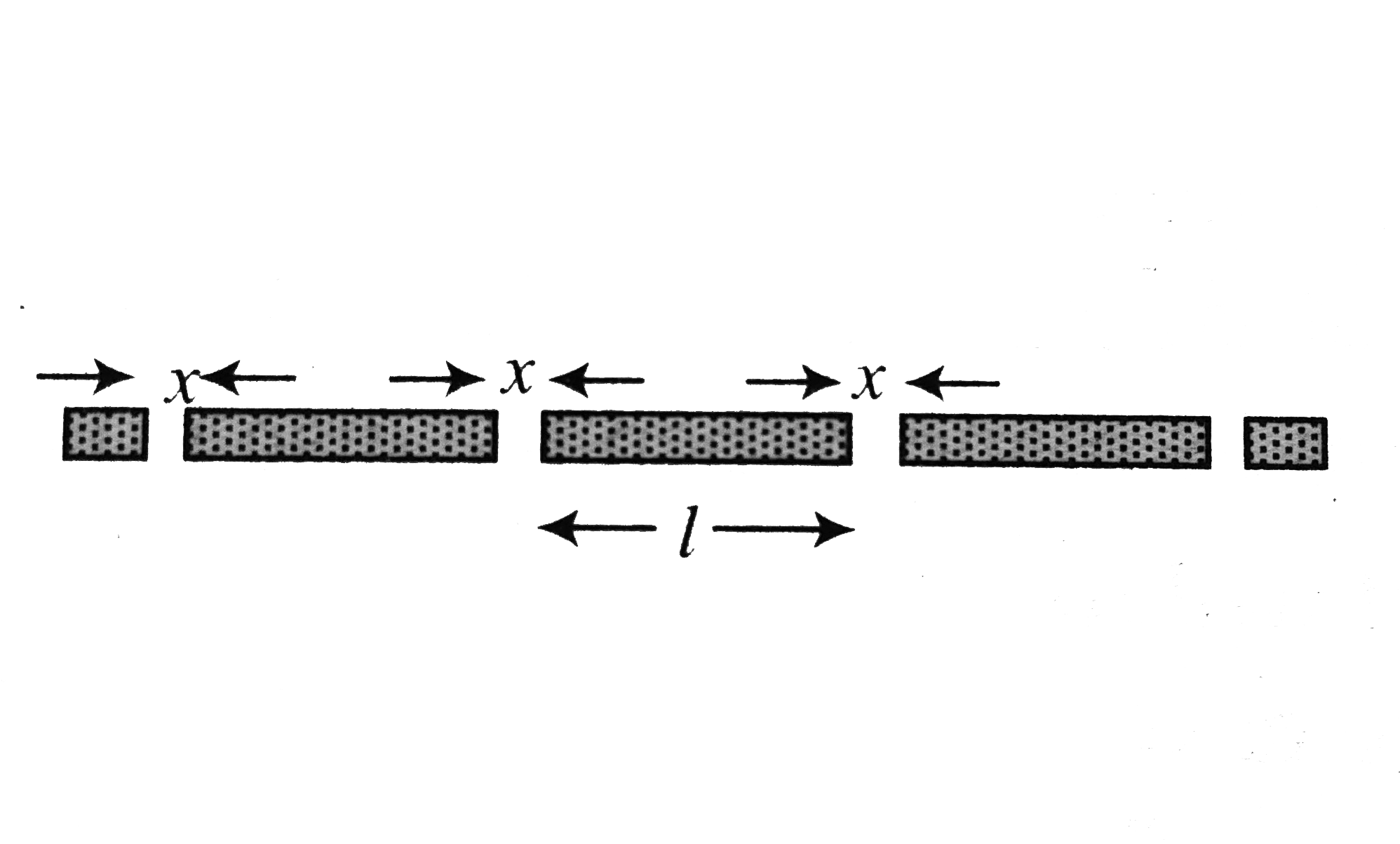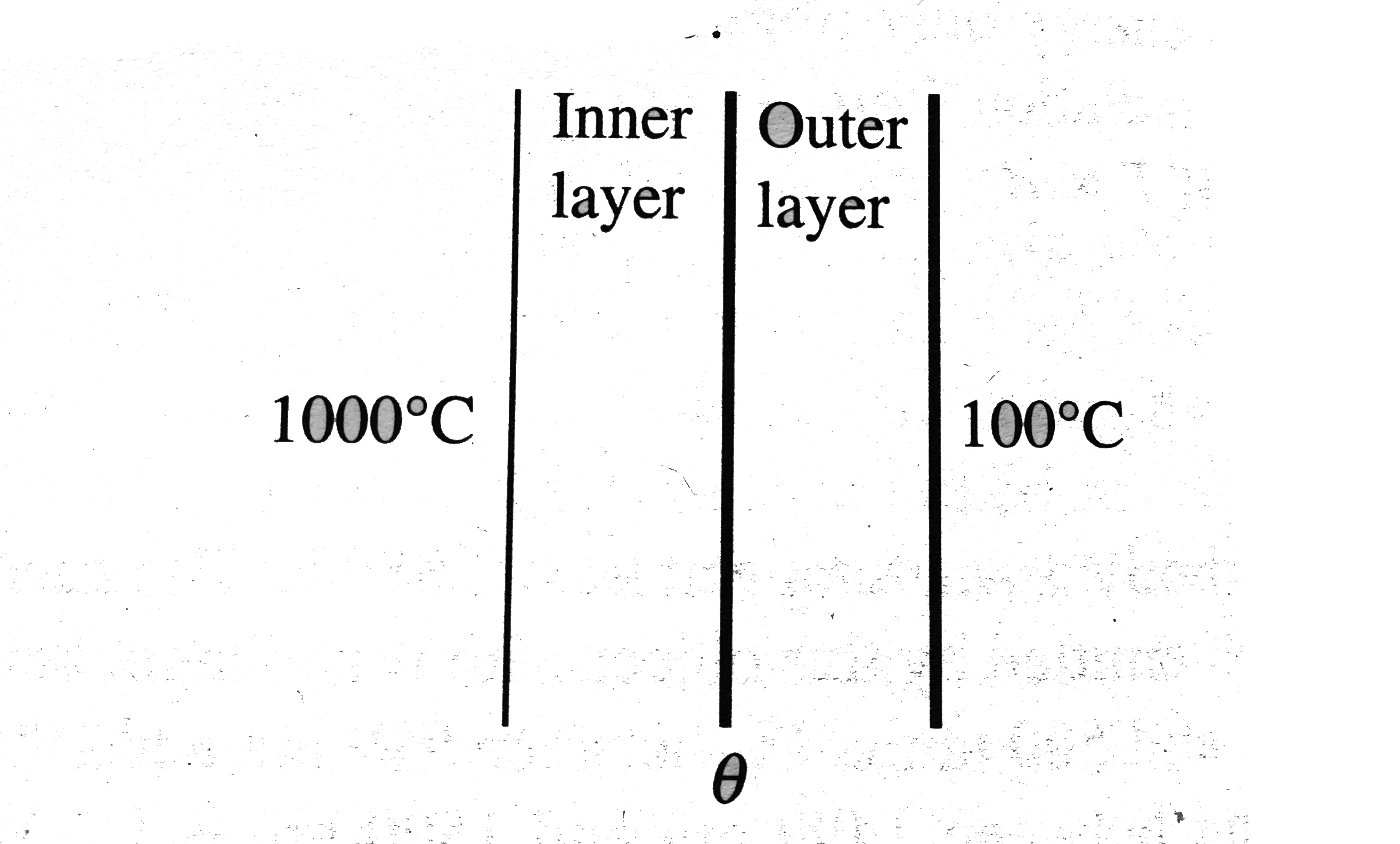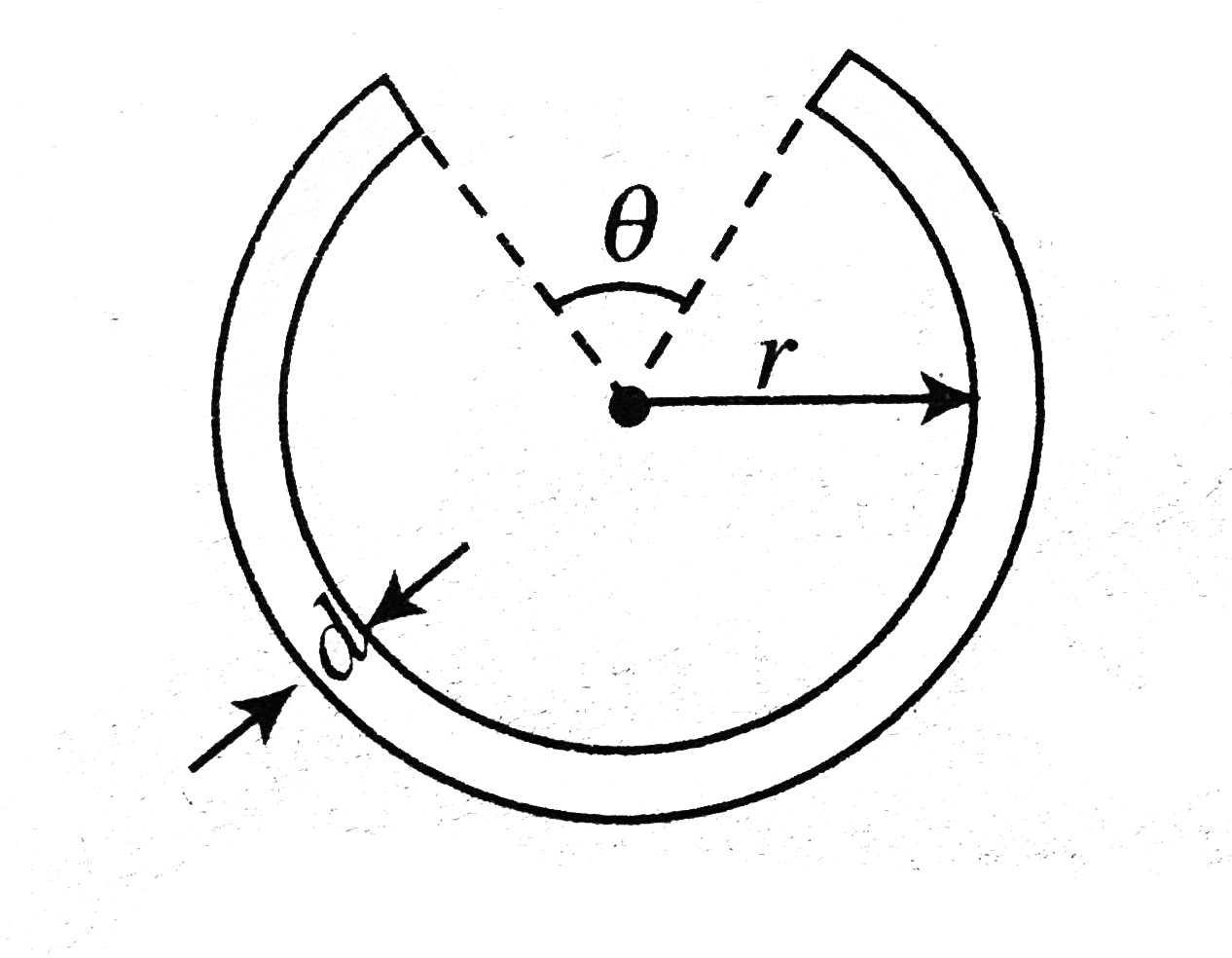Exercise 1.3 from CENGAGE PHYSICS (HINGLISH) CALORIMETRY for Class 11
| Class 11 | PHYSICS |
| Chapter | CALORIMETRY |
| CENGAGE PHYSICS (HINGLISH) | Exercise 1.3 |
| Medium | English |
| Academic Year | 2023-2024 |
Question 11
Steam at 100∘C is passed into a calorimeter of water equivalent 10 g containing 74 cc of water and 10 g of ice at 0∘C. If the temperature of the calorimeter and its contents rises to 5∘C, calculate the amount of steam passed. Latent heat of steam=540kcal/kg, latent heat of fusion=80kcal/kg.View SolutionQuestion 13
When a small ice crystal is placed in overcooled water it begins to freeze instantaneously.
i. What amount of ice is formed from 1 kg of water over cooled to −8∘C ? L of water =336×103J/kg and s of water=4200J/kg/K.
ii. What should be the temperature of the overcooled water in order that all of it be converted into ice at 0∘C ?View SolutionQuestion 15
An ice cube whose mass is 50g is taken from a refrigerator where its temperature was −10∘C. If no heat is gained or lost from outside, how much water will freeze onto the cube if it is dropped into a beaker containing water at 0∘C? Latent heat of fusion=80kcal/kg, specific heat capacity of ice=500cal/kg/K.View SolutionQuestion 18
Equal masses of three liquids A,B and C are taken. Their initial temperature are 10∘C,25∘C and 40∘C respectively. When A and B are mixed the temperature of the mixutre is 19∘C. When B and C are mixed, the temperature of the mixture is 35∘C. Find the temperature if all three are mixed.View SolutionQuestion 19
An earthen pitcher loses 1 g of water per minute due to evaporation. If the water equivalent of pitcher is 0.5 kg and the pitcher contains 9.5 kg of water, calculate the time required for the water in the pitcher to cool to 28∘C from its original temperature of 30∘C Neglect radiation effect. Latent heat of vapourization of water in this range of temperature is 580 cal/g and specific heat of water is 1kcal/gC∘View SolutionQuestion 20
A certain amount of ice is supplied heat at a constant rate for 7 minutes. For the first one minute the temperature rises uniformly with time. Then, it remains constant for the next 4 minute and again the temperature rises at uniform rate for the last two minutes. Calculate the final temperature at the end of seven minutes.
(Given, L of ice =336×(103)J/kg and specific heat of water =4200J/kg.K).View SolutionQuestion 33
A metal rod of 30 cm length expands by 0.075 cm when its temperature is raised from 0∘C to 100∘C. Another rod of a different metal of length 45 cm expands by 0.045 cm for the same rise in temperature. A composite rod C made by joining A and B end to end expands by 0.040 cm when its length is 45 cm and it is heated from 0∘C to 50∘C. Find the length of each portion of the composite rod.View SolutionQuestion 36
A mercury in glass thermometer has a stem of internal diameter 0.06 cm and contains 43 g of mercury. The mercury thread expands by 10 cm when the temperature changes from 0∘C to 50∘C. Find the coefficient of cubical expansion of mercury. Relative density of mercury =13.6 and αglass=9×10−6/K.View SolutionQuestion 37
A sphete of deamrter 7.0 cm and mass 266.5 g float in a bath of liquid. As the temperature is raised, the sphere begins to sink at a temperature of 35∘C. If the density of liqued is 1.527gcm−3 at0∘C, find the coeffiecient of cubical expamsion of the liquid. Neglect the expansion of the sphere.View SolutionQuestion 38
A mercury thermometer is to be made with glass tubing of internal bore 0.5 mm diameter and the distance between the fixed point is to be 20 cm. Estimate the volume of the bulb below the lower fixed point, given that the coefficient of cubical expansion of mercury is 0.00018/K. and the coefficient of linear expansion of glass is 0.000009/K.View SolutionQuestion 39
On a Celsius thermometer the distance between the readings 0∘C and 100∘C is 30cm and the area of cross section of the narrow tube containing mercury is 15×10−4cm2. Find the total volume of mercuty in the thermometer at 0∘C. α of glass=9×10−6/K and the coefficient of real expansion of mercury=18×10−5/K. View SolutionQuestion 40
The height of a mercury column measured with a brass scale, which is correct and equal to H0 at 0∘C, is H1 at t∘C? The coefficient of linear expansion of brass is α and the coefficient of linear expansion of brass is α and the corfficient of volume expansion of mercury is γ. Relate H0 and H1.View SolutionQuestion 42
Two rods of equal cross sections, one of copper and the other of steel, are joined to form a composite rod of length 2.0 m at 20∘C, the length of the copper rod is 0.5 m. When the temperature is raised to 120∘C, the length of composite rod increases to 2.002m. If the composite rod is fixed between two rigid walls and thus not allowed to expand, it is found that the lengths of the component rods also do not change with increase in temperature. Calculate Young's moulus of steel. (The coefficient of linear expansion of copper, αc=1.6×10−5∘C and Young's modulus of copper is 1.3×1013N/m2).View SolutionQuestion 49
A brass boiler has a base area of 0.15m2 and thickness 1.0 cm it boils water at the rate of 6.0kg/min, When placed on a gas. Estimate the temperature of the part of the flame in contact with the boiler. Thermal conductivity of brass=109J/s−.∘C ) and heat of vapourization of water =2256J/g.View SolutionQuestion 50
An electric heater is placed inside a room of total wall area 137m2 to maintain the temperature inside at 20∘C. The outside temperature is −10∘C. The walls are made of three composite materials. The inner most layer is made of wood of thickness 2.5 cm the middle layer is of cement of thickness 1 cm and the exterior layer is of brick of thickness 2.5 cm. Find the power of electric heater assuming that there is no heat losses through the floor and ceiling. The thermal conductivities of wood, cement and brick are 0.125W/m.∘C,1.5W/m.∘Cand1.0W/m.∘C respectively. View SolutionQuestion 53
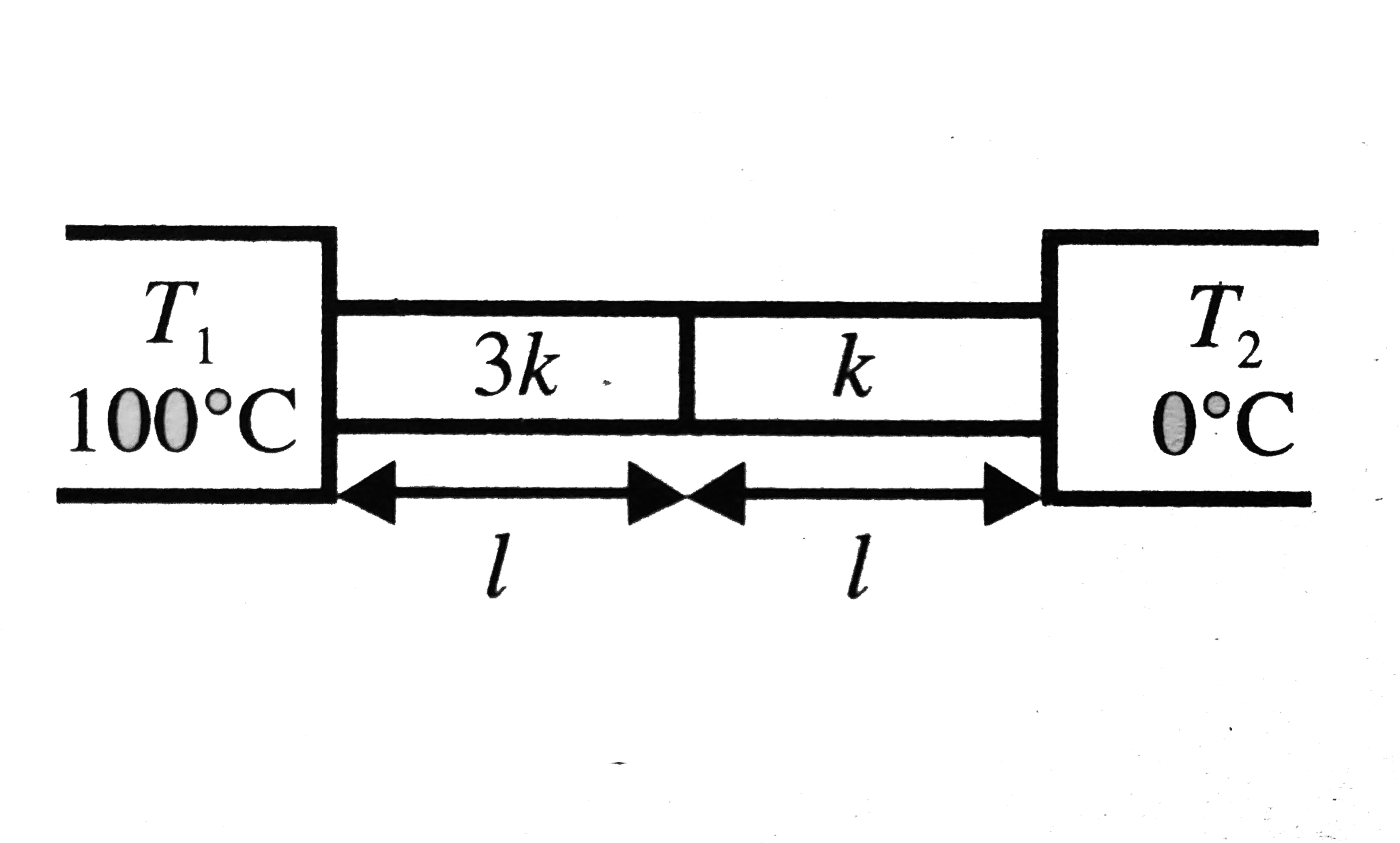
Two rods A and B of same length and cross-sectional area are connected in series and a temperature difference of 100∘C is maintained across the combination as shoen in Fig. If the thermal conductivity of the rod A is 3 k and that of rod B is k, Then
i.Determine the thermal resistance of each rod.
ii. determine the heat current flowing through each rod.
iii. determine the heat current flowing through each rod.
iv. plot the variation of temperature along the length of the rod.View SolutionQuestion 56
One end of a brass rod of length 2.0 m and cross section 1cm2 is kept in stream at 100∘C and the other end in ice at 0∘C. The lateral suface of the rod is covered by heat insulator. Determine the amount of ice melting per minute. Thermal conductivity of brass is 110W/m−K and specific latent heat of fusion of ice is 80cal/g.View SolutionQuestion 61
A spherical ball of radius 1cm coated with a metal having emissivity 0.3 is maintained at 1000 K temperature and suspended in a vacuum chamber whose walls are maintained at 300 K temperature. Find rate at which electrical energy is to be supplied to the ball to keep its temperature constant.View SolutionQuestion 65
The temperatures of equal masses of three different liquids A, B and C are 15∘C, −20∘C and 30∘C, respectively. When A and B are mixed their equilibrium temperature is 180∘C. When B and C are mixed, it is 22∘C .What will be the equilibrium temperature when liquids A and C are mixedView SolutionQuestion 66
A copper cube of mass 200g slides down an a rough inclined plane of inclination 37∘ at a constant speed. Assume that any loss in mechanical energy goes into the copper block as thermal energy .Find the increase in the temperature of the block as it slides down through 60cm. Specific heat capacity of copper =420Jkg−1K−1View SolutionQuestion 72
A rod AB of length l is pivoted at an end A and freely rotated in a horizontal plane at an angular speed ω about a vertical axis passing through A. If coefficient of linear expansion of material of rod is α, find the percentage change in its angular velocity if temperature of system is incresed by ΔTView SolutionQuestion 73
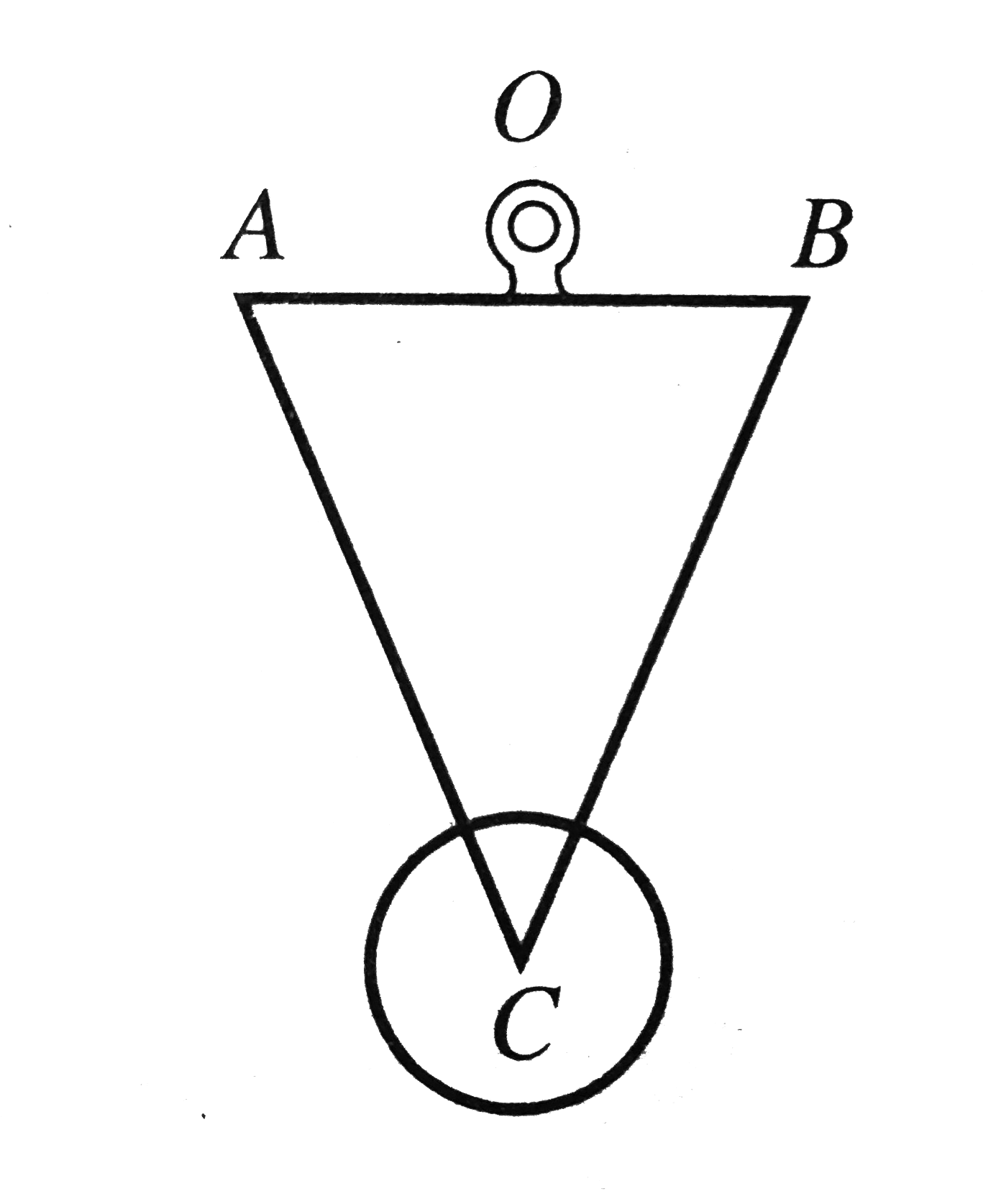
A compensated pendulum shown if Fig. is in the from of an isosceles Delta of base length l1=5cm and coefficent of linar expansion α1=18×10−6 and side length l2 and coefficient of linear expansion α2=12×10−6. find l2 so the the distance of centre of mass of the bob from suspension centre O may remain the same at all the temperature.View SolutionQuestion 74
A aluminium can of cylindrical shape contains 500cm3 of water. The area of the inner cross section of the can is 125cm2. All measurements refer ti 10∘C. Find the rise in the water level if the temperature increases to80∘C. The coefficient of linear expansion of aluminium =23×10−6∘C(−1) respectively.View SolutionQuestion 75
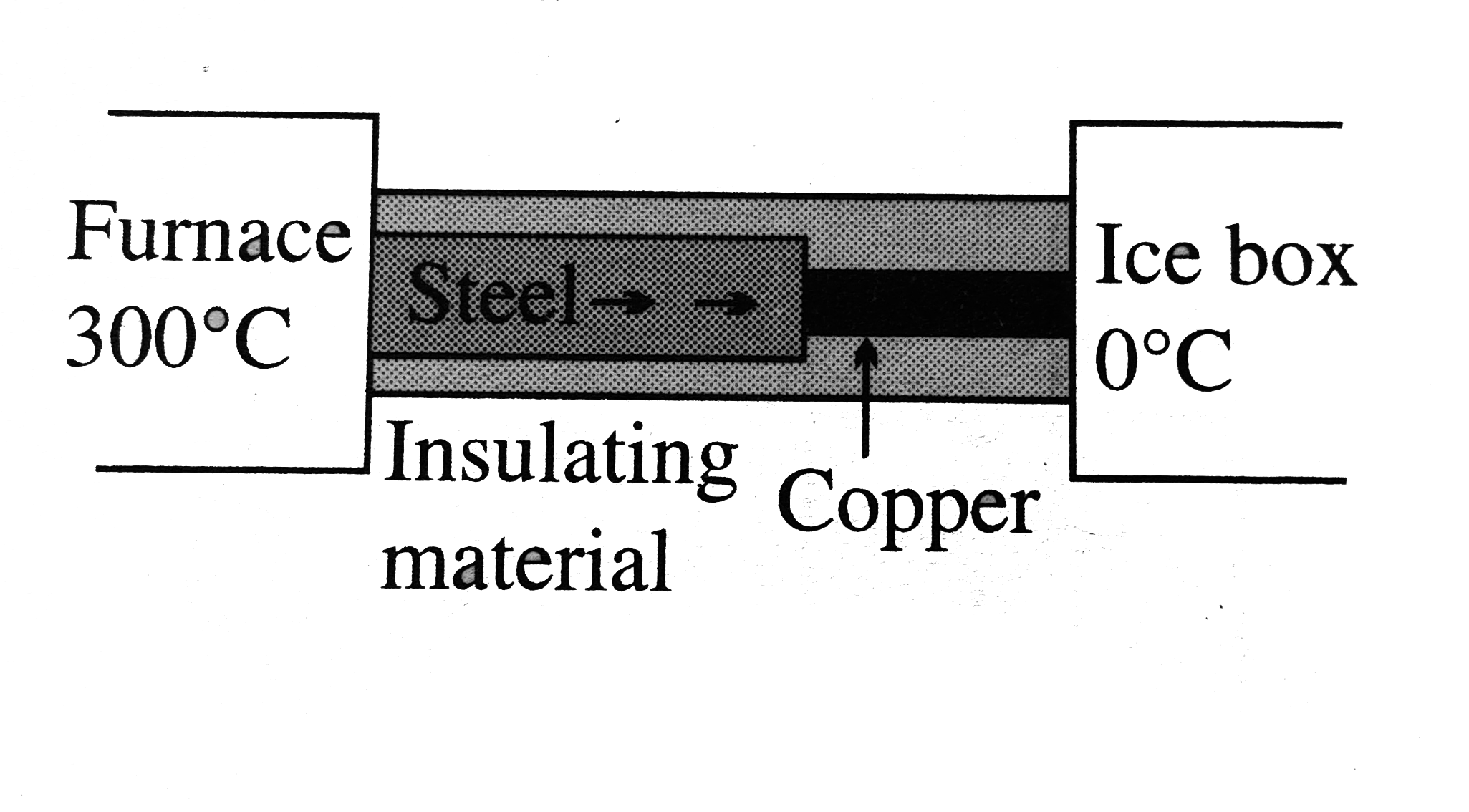
What is the temperature of the steel-copper junction in the steady state of the system shown if Fig? Length of the steel rod =25cm, length of the copper rod=50cm, temperature of the furnace=300∘C, temperature of the other end =0∘C. The area of cross section of the steel rod is twice that of the copper rod. (Thermal conductivity of steel =50J/sm and of copper =400Js/mK).View SolutionQuestion 76
We would like to increase the length of a 15 cm long copper rod of cross section 4mm2 by 1 mm. The energy absorbedd by the rod if it is heated is E1. The energy absorbed by the rod if it is stretched slowly is E2. Then find E1/E2. [Variaous parameters of copper are density =9×103Kg/m3, thermal coefficient of linear expansion =16×10−6/K, Young's modulus =135×190Pa, specific heat =400J/kg−K]View SolutionQuestion 78
A cylinderical brass boiler of radius 15 cm and thickness 1.0 cm is filled with water and placed on an elerctric heater. If the If the water boils at the rate of 200g/s, estimate the temperature of the heater filament. Thermal conductivity of brass=109J/s/m∘C and heat of vapourization of water =2.256×103J/g.View SolutionQuestion 79
The lower surface of a slab of stone of face-area 3600cm2 and thickness 10cm is exposed to steam at 100∘C . A block of ice at 0∘C rests on the upper surface of the slab. 4.8g of ice melts in one hour. Calculate the thermal conductivity of the stone. Latent heat of fusion of ice =3.36×105Jkg−1View SolutionQuestion 81
A solid metallic sphere of diameter 20 cm and mass 10 kg is heated to a temperature of 327∘C and suspended in a box in which a constant temperature of 27∘C is maintained. Find the rate at which the temperature of the Sphere will fall with time. Stefan's constant=5.67×10−8W/m2/K4 and specific heat of metal =420J/kg/∘C.View SolutionQuestion 82
Figure shows water in a container having 2.0mm thick walls made of a material of thermal conductivity 0.50Wm−1.∘C−1 . The container is kept in a melting-ice bath at 0∘C . The total surface area in contact with water is 0.05m2 . A wheel is clamped inside the water and is coupled to a block of mass M as shown in the figure. As the block goes down, the wheel rotates. It is found that after some time a steady state is reached in which the block goes down with a constant speed of 10cm−1 and the temperature of the water remains constant at 1.0∘C .Find the mass M of the block. Assume that the heat flow out of the water only through the walls in contact. Take g=10ms−2 .
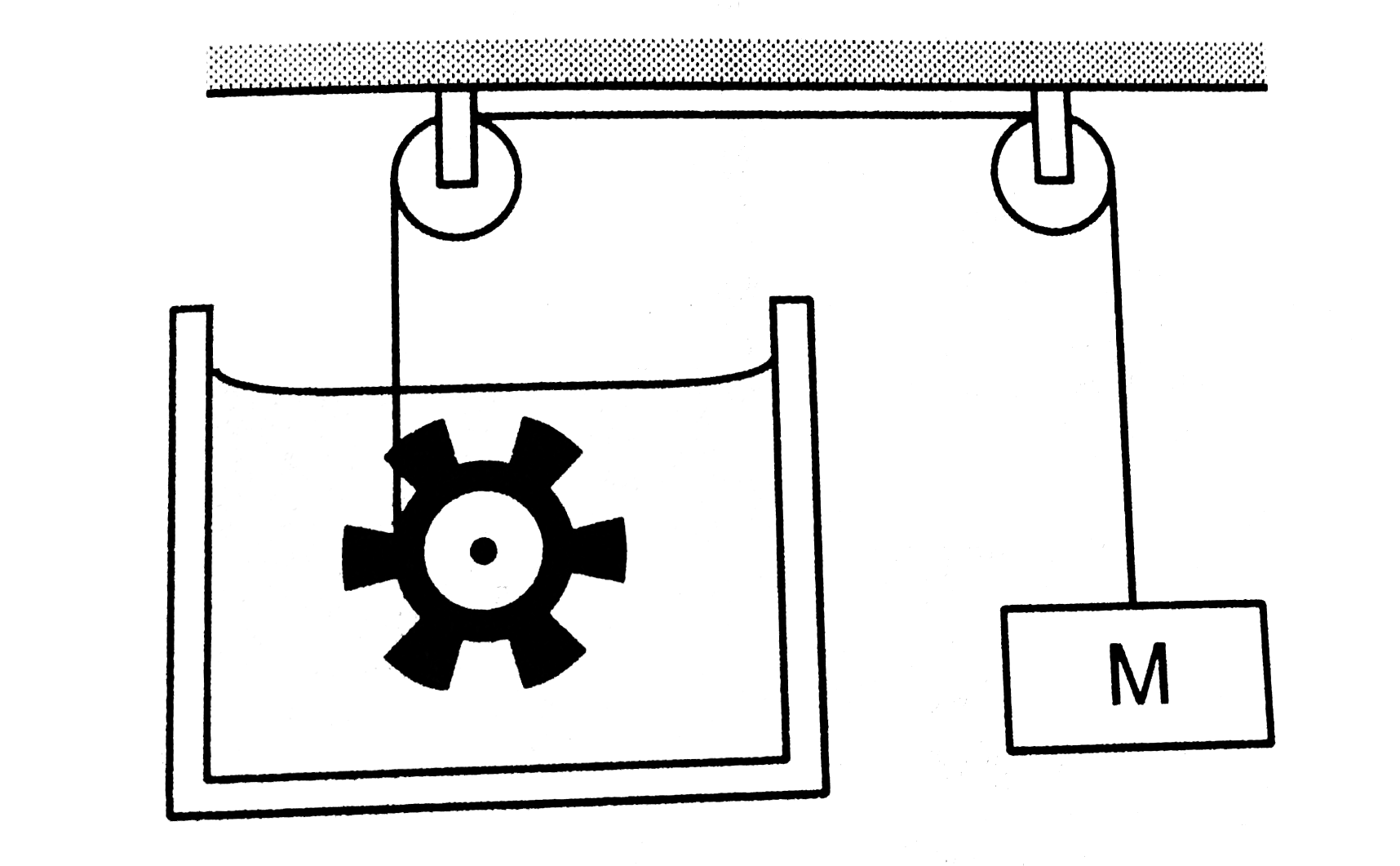 View Solution
View SolutionQuestion 83
Let us assume that sun radiates like a black body with surface temperature at T0=6000K and earth absorbs radiation coming from sun only. If both earth and sun are considered perfect spheres with distance between centre of earth and centre of sun to be 200 times the radius of sun, find the temperature (in Kelvin) of surface of earth in steady state (assume radiation incident on earth to be almost parallel).View SolutionQuestion 84
Water flows at the rate of 0.1500kg/min through a tube and is heated by a heater dissipating 25.2W. The inflow and outflow water temperatures are 15.2∘C and 17.4∘C, respectively. When the rate of flow is increased to 0.2318kg/min and the rate of heating to 37.8W, the inflow and outflow temperature are unaltered. Find
i. the specific heat capacity of water
ii. the rate of loss of heat from the tube.View SolutionQuestion 85
A piece of metal weighs 46 g in air and 30 g in lipuid of density 1.24×103kgm−3 kept at 270C. When the temperature of the liquid is raised to 420C the metal piece weights 30.5 g . The density of the liqued at 420C is 1.20×103kgm−3. Calculate the coefficient of linear expandsion of the metal.View SolutionQuestion 86
Two steel rods and an aluminium rod of equal length l0 and equal cross- section are joined rigidly at their ends as shown in the figure below. All the rods are in a state of zero tension at 0∘C
 . Find the length of the system when the temperature is raised to θ. Coefficient of linear expansion of aluminium and steel are αa and αs respectively. Young's modulus of aluminium is Ya and of steel is Ys.View Solution
. Find the length of the system when the temperature is raised to θ. Coefficient of linear expansion of aluminium and steel are αa and αs respectively. Young's modulus of aluminium is Ya and of steel is Ys.View SolutionQuestion 87
The apparatus shown in the figure consists of four glass columns connected by horizontal section. The height of two central column B and C are 49 cm each. The two outer columns A and D are open to the temperature. A and C are maintained at a temperature of 95∘C while the columns B and D are maintained at 5∘C. The height of the liquid in A and D measured from the base the are 52.8 cm and 51cm respectively. Determine the coefficient of thermal expansion of the liquid
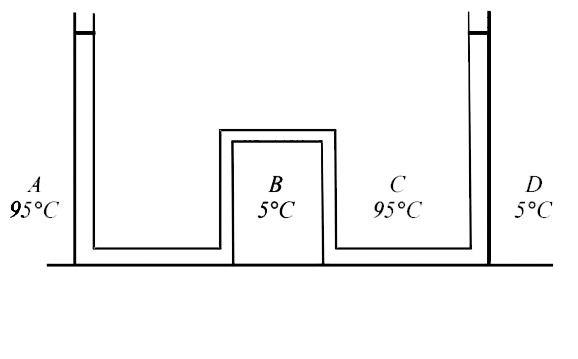 View Solution
View SolutionQuestion 88
A cylindrical rod of length 50cm and cross sectional area 1cm2 is fitted between a large ice chamber at 0∘C and an evacuated chamber maintained at 27∘C as shown in figure. Only small portions of the rod are inside the chamber and the rest is thermally insulated from the surrounding. The cross section going into the evacuated chamber is blackened so that it completely absorbs any radiation falling on it. The temperature of the blackened end is 17∘C when steady state is reached. Stefan constant σ=6×10−sWm−2K−4 . Find the thermal conductivity of the material of the rod.
 View Solution
View SolutionQuestion 90
An isosceles triangles is formed with a thin rod of length l1 and coefficient of linear expansion α1, as the base and two thin rods each of length l2 and coefficient of linear expansion α2 as the two sides. The distance between the apex and the midpoint of the base remain unchanged as the temperature is varied. The ratio of lengths l1l2 is
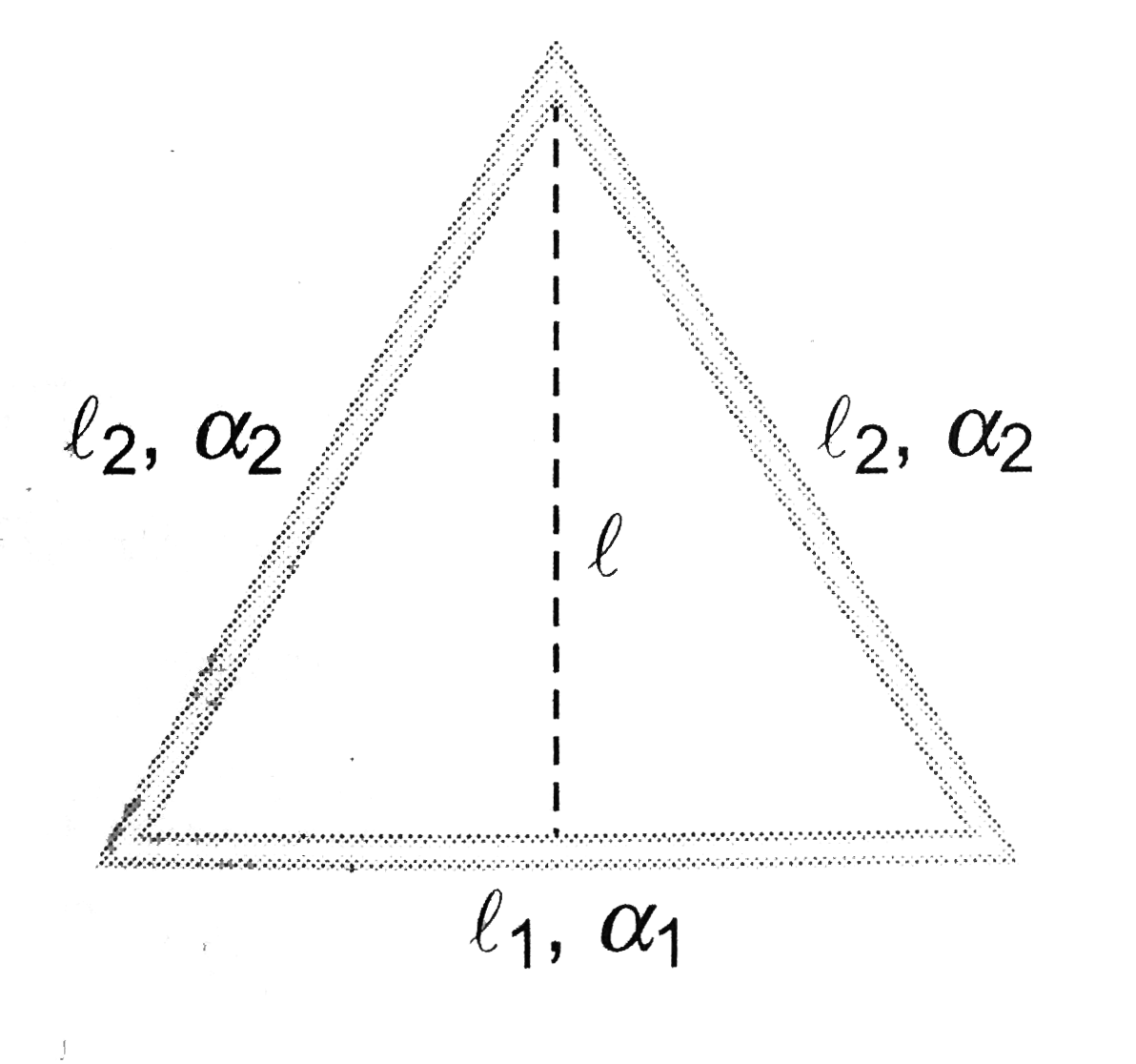 View Solution
View SolutionQuestion 91
An iron rod of length 50 cm is joined at an end to aluminium rod of length 100 cm. All measurements refer to 20_0 C . Find the length of the composite system at 1000 C. and its average coefficent of linear expansion. The coefficient o f linear expansion o f iron and aluminium are 10 xx 10_-6 0 C_-1 and 24 xx10_-6 0 C _-1 respectively.View SolutionQuestion 110
In an industrial process 10 kg of water per hour is to be heated from 20∘C to 80∘C. To do this steam at 150∘C is passed from a boiler into a copper coil immersed in water. The steam condenses in the coil and is returned to the boiler as water at 90∘C. How many kilograms of steam is required per hour (specific heat of steam=1cal/g∘C, Latent heat of vapourization=540cal/g)?View SolutionQuestion 113
A semicircular rods is joined at its end to a straight rod of the same material and the same cross-sectional area. The straight rod forms a diameter of the other rod. The junctions are maintained at different temperatures. Find the ratio of the heat transferred through a cross section of the semicircular rod to the heat transferred through a crossection of the straight rod in a given time. View SolutionQuestion 116
A point source of heat of power P is placed at the centre of a spherical shell of mean radius R. The material of the shell has thermal conductivity K. If the temperature difference between the outer and inner surface of the shell in not to exceed T, the thickness of the shell should not be less than .......View SolutionQuestion 117
There are three thermometers one in contact with the skin of the man other in between the vest and the shirt and third in between the shirt and coat. The readings of the thermometers are 30∘C,25∘C and 22∘C, respectively. If the vest and the shirt are of the same thickness, the ratio of their thermal conductivities isView SolutionQuestion 122
An ice box used for keeping eatables cool has a total wall area of 1m2 and a wall thickness of 5.0 cm. The thermal conductivity of the ice box is K=0.01J/m∘C. It is filled with large amount of ice at 0∘C along with eatables on a day when the temperature is 30∘C The latent heat of fusion of ice is 334×103J/kg. The amount of ice melted in one day is ( 1 day=86,000s)View SolutionQuestion 123

The only possibility of heat flow in a thermos flask is through its cork which is 75cm2 in area and 5 cm thick its thermal conductivity is 0.0075cal/cm−s−∘C. The outside temperature is 40∘C and latent heat of ice is 80cal/g. Time taken by 500 g of ice at 0∘C in the flask to melt into water at 0∘C is View SolutionQuestion 130
A solid copper cube of edges 1 cm is suspended in an evacuated enclosure. Its temperature is found to fall from 100∘C to 99∘C in 100 s. Another solid copper cube of edges 2 cm, with similar surface nature, is suspended in a similar manner. The time required for this cube to cool from 100∘C to 99∘C will be approximatelyView SolutionQuestion 138
There are two thin spheres A and B of the same material and same thickness. They behave like black bodies, Radius of A is double that of B and Both have same temperature T. When A and B are kept in a room of temperature T0(<T), the ratio of their rates of cooling is (assume negligible heat exchange between A and B).View SolutionQuestion 139
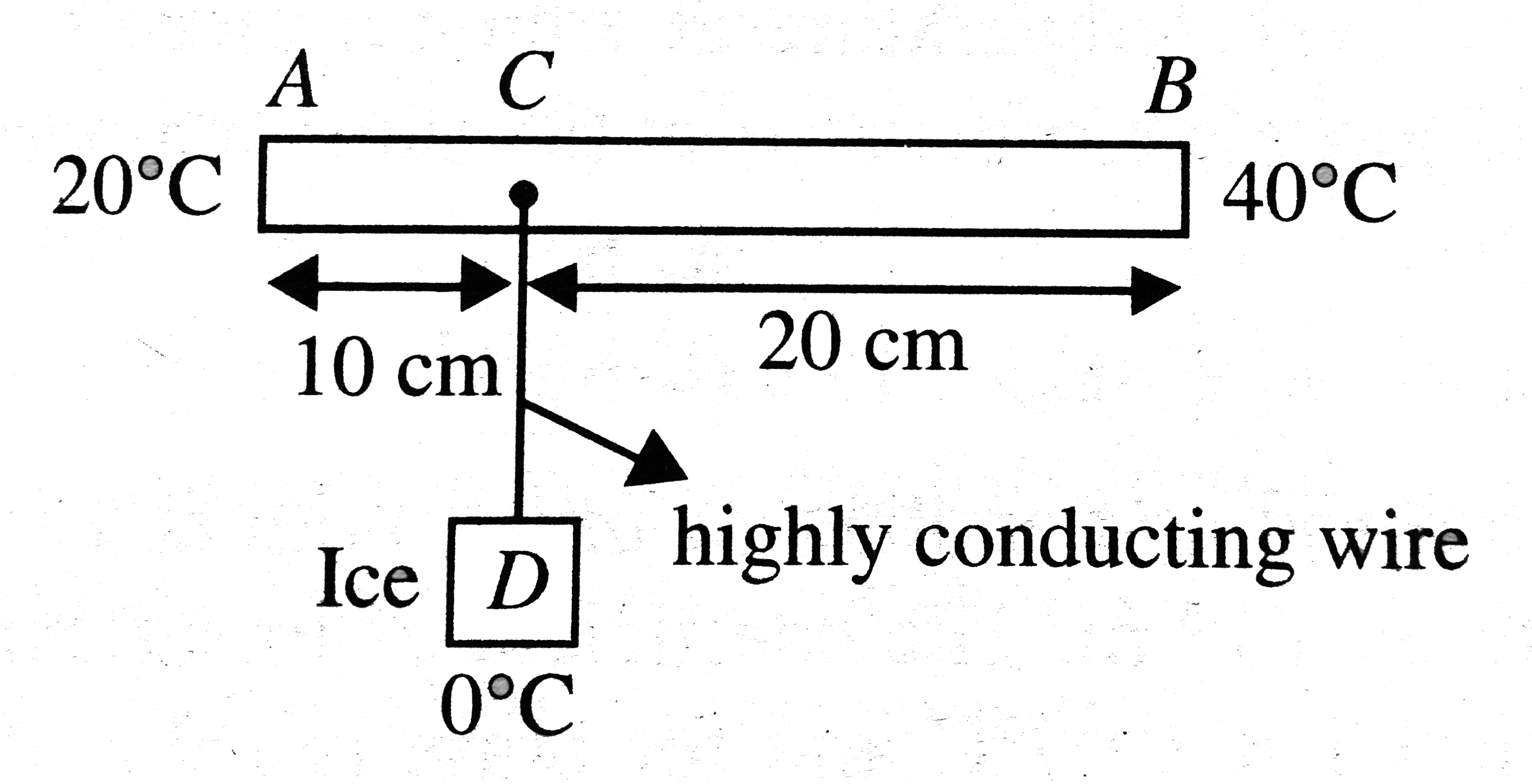
As shown in Fig. AB is rod of length 30 cm and area of cross section 1.0cm2 and thermal conductivity 336 SI units. The ends A and B are maintained at temperatures 20∘C and 40∘C, respectively .A point C of this rod is connected to a box D, containing ice at 0∘C through a highly conducting wire of negligible heat capacity. The rate at which ice melts in the box is (assume latent heat of fusion for ice Lf=80cal/g)View SolutionQuestion 143
A solid metallic sphere of diameter 20 cm and mass 10 kg is heated to a temperature of 327∘C and suspended in a box in which a constant temperature of 27∘C is maintained. Find the rate at which the temperature of the Sphere will fall with time. Stefan's constant=5.67×10−8W/m2/K4 and specific heat of metal =420J/kg/∘C.View SolutionQuestion 145
A wire is made by attaching two segments together end to end. One segment is made of aluminium and the other is steel. The effective coefficient of linear expansion of the two segment wire is 19×10−6/∘C. The fraction length of aluminium is (linear coefficient of thermal expansion of aluminium and steel are 23×10−6.∘C and 12×10−6/∘C,View SolutionQuestion 149
A thread of liquid is in a uniform capillary tube of length L. As measured by a ruler. The temperature of the tube and thread of liquid is raised by ΔT. If γ be the coefficient of volume expansion of the liquid and α be the coefficient of linear expansion of the material of the tube, then the increase ΔL in the length of the thread, again measured by the ruler will be View SolutionQuestion 150
A brass wire 2 m long at 27∘C is held taut with negligible tension between two rigid supports. If the wire is cooled to a temperature of −33∘C, then the tension developed in the wire, its diameter being 2 mm, will be (coefficient of linear expansion of brass=2.0×10−5/∘C and Young's modulus of brass =0.91×1011Pa)View SolutionQuestion 151
A mass m of lead shot is placed at the bottom of a vertical cardboard cylinder that is 1.5 m long and closed at both ends. The cylinder is suddenly inverted so that the shot falls 1.5 m If this procces is repeated quickely 100 times, auuming no heat is dissipated or lost, the temperature of the shot will increase by (specific heat of lead=0.03cal/g∘C)View SolutionQuestion 152
An iron rocket fragment initially at −100∘C enters the earth's atmosphere almost horizontally and quickly fuses completely in atmospheric friction. Specific heat of iron is 0.11kcal/kg∘C. Its melting point is 1535∘C and the latent heat of fusion is 3kcals/kg. The minimum velocity with which the fragmento must have entered the atmosphere isView SolutionQuestion 153
A liquid of density 0.85g/cm3 flows through a calorimeter at the rate of 8.0cm2/s. Heat is added by means of a 250 W electric heating coil and a temperature difference of 15∘C is established in steady state conditions between the inflow and the outflow points of the liquid. The specific heat for the liquid will beView SolutionQuestion 154
An iron ball (coefficient of linear expansion=1.2×(10−5/∘C) has a diameter of 6 cm and is 0.010 mm too large to pass through a hole in a brass plate (coefficient of linear expansion=1.9×10−5/∘C) when the ball and the plate are both at a temperature of 30∘C At what common temperature of the ball and the plate will the ball just pass through the hole in the plate ?View SolutionQuestion 155
A flask of mercury is sealed off at 20∘C and is completely filled with mercury. If the bulk modulus for mercury is 250 Mpa and the coefficient of volume expansion of mercury is 1.82×10−4/∘C and the expansion of glass is ignored, the pressure of mercury within flask at 100∘C will be View SolutionQuestion 158
An ordinary refrigerator is thermally equivalent to a box of corkboard 90 mm thick and 5.6m2 in inner surface area. When the door is closed, the inside wall is kept, on the average, 22.2∘C below the temperature of the outside wall. If the motor of the refrigerator runs 15% of the time while the door is closed, at what rate must heat be taken from the interior whicle the motor is running?
The thermal conductivity of corkboard is k=0.05W/mK.View SolutionQuestion 159
A bullet of mass 5 g moving at a speed of 200 m/s strikes a rigidly fixed wooden plank of thickness 0.2m normally and passes through it losing half of its kinetic energy. If it again strikes an identical rigidly fixed wooden plank and passes through it, assuming the same resistance in the two planks the ratio of the thermal energies produced in the two planks is View SolutionQuestion 160

A and B are tqo isolated spheres kept in close proximity so that they can exchange energy by radiation. The two spheres have identical physical dimensions but the surface of A behaves like a perfactly black body while the surface of B reflects 20% of all the radiations it receives. They are isolated from all other sources of radiation.View SolutionQuestion 161
A thermally isulated piece of metal is heated under atmospheric pressure by an electric current so that it receives electric energy at a constant power P. This leads to an increase of absolute temperature T of the metal with time t as follows:
T(t)=T0[1+a(t−t0)]1/4. Here, a, t0 and T0 are constants. The heat capacity Cp(T) of the metal is View SolutionQuestion 162
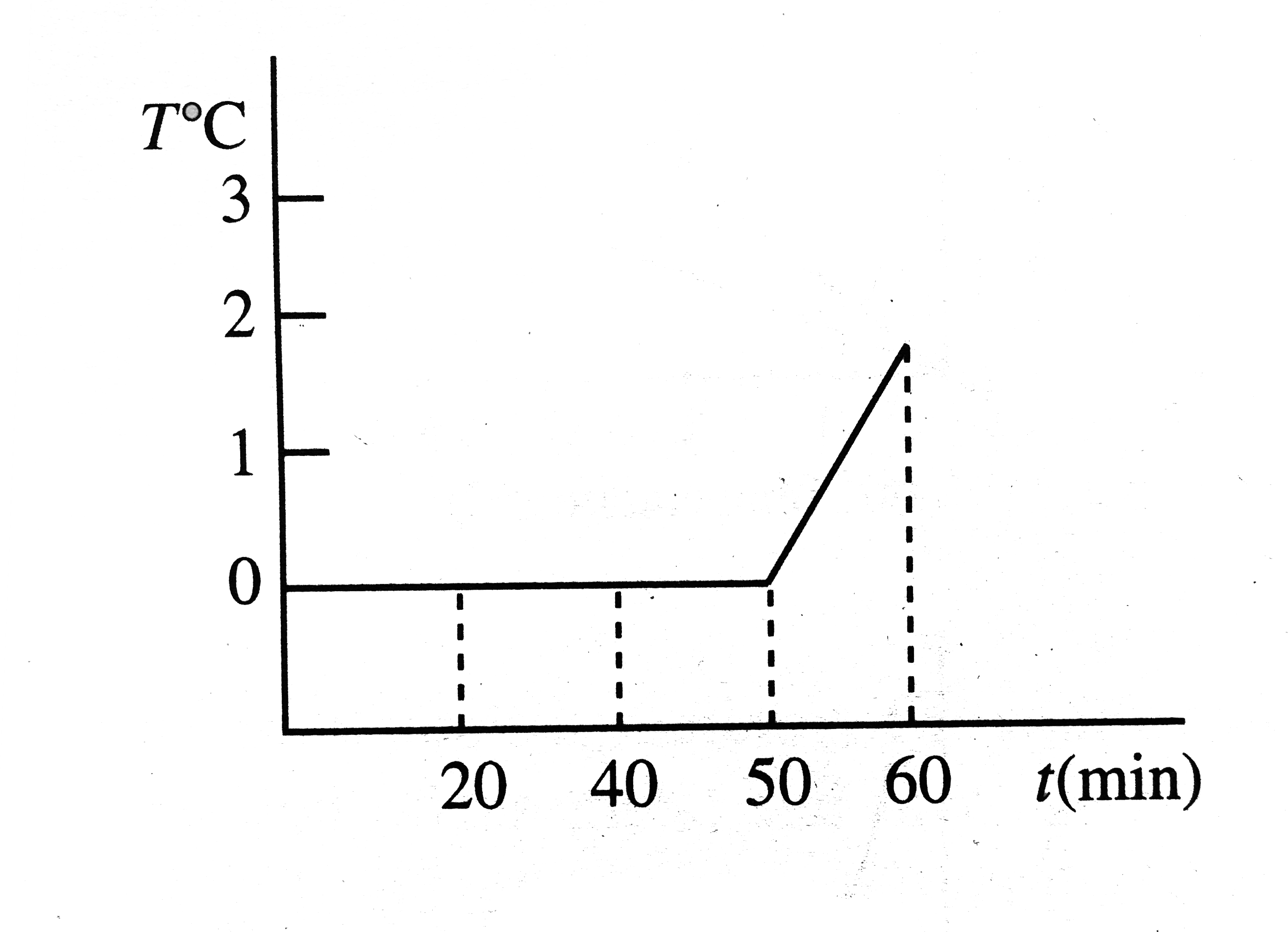
A cooking vessel on a slow burner contains 5 kg of water and an unknown mass of ice in equilibrium at 0∘C at time t=0. The temperature of the mixture is measured at various times and the result is plotted as shown in Fig. During the first 50 min the mixture remains at 0∘C. From 50 min to 60 min, the temperature increases to 2∘C Neglecting the heat capacity of the vessel, the initial mass of the ice isView SolutionQuestion 163
A glass cylinder contains m0=100g of mercury at a temperature of t0=0∘C. When temperature becomes t1=20∘C the cylinder contains m1=99.7g of mercury The coefficient of volume expansion of mercury γHe=18×(10−5/∘C Assume that the temperature of the mercury is equal to that of the cylinder. The corfficient of linear expansion of glass α is View SolutionQuestion 165
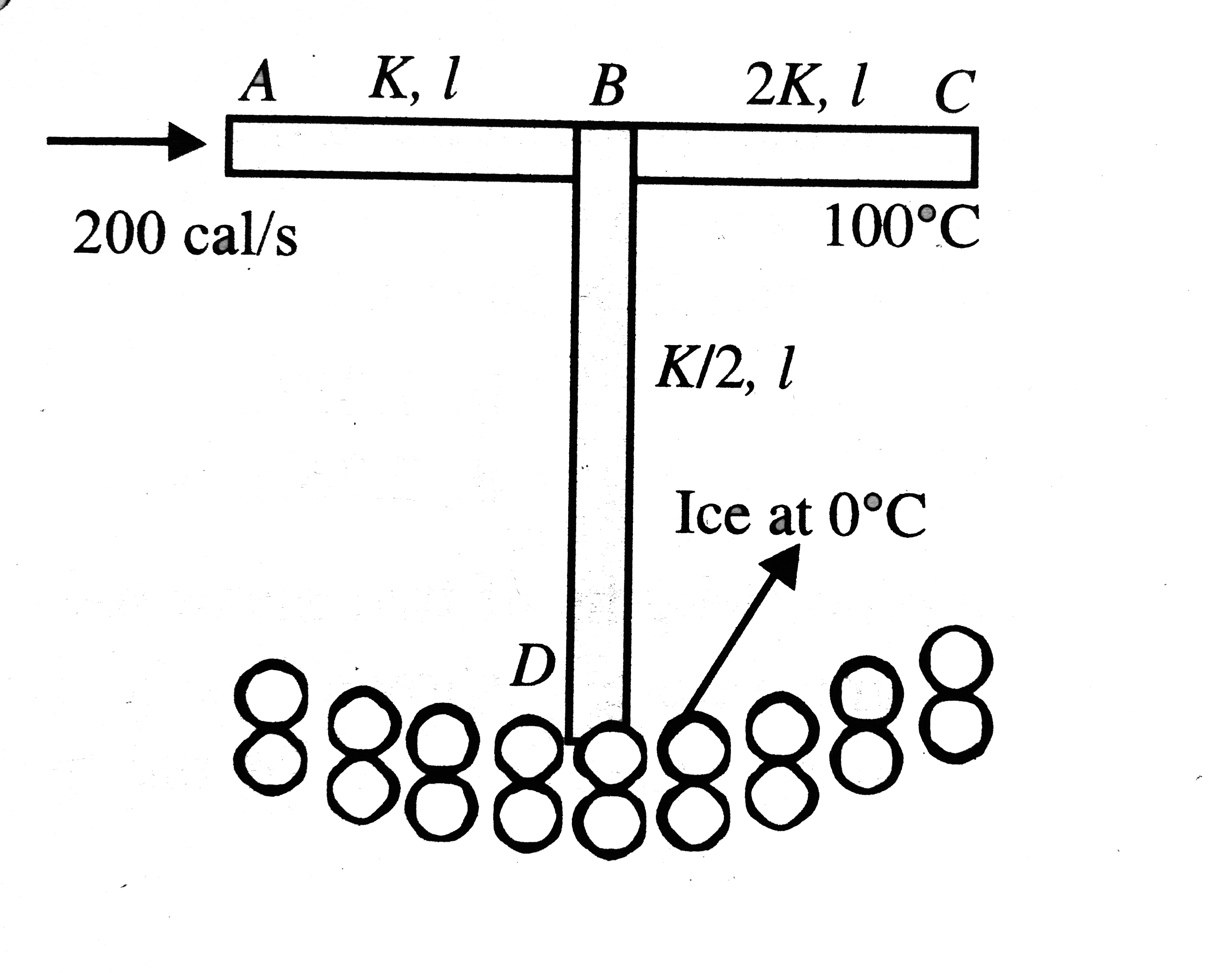
Three rods AB, BC and BD of same length l and cross section A are arranged as shown. The end D is immersed in ice whose mass is 440 g and is at 0∘C. The end C is maintained at 100∘C. Heat is supplied at constant rate of 200 cal/s. Thermal conductivities of AB, BC and BD are K, 2K and K/2, respectively Time after which whole ice will melt is (K=100cal/m−s∘CA=10cm2,l=1cm)View SolutionQuestion 167
A container of capacity 700 mL is filled with two immiscible liquids of volume 200 mL and 500 mL with respective volume expansivities as 1.4×10−5/∘C and 2.1×10−5/∘C. During the heating of the vessel, it is observed that neither any liquid overflows nor any empty space is created. The volume expansivity of the container is View SolutionQuestion 173
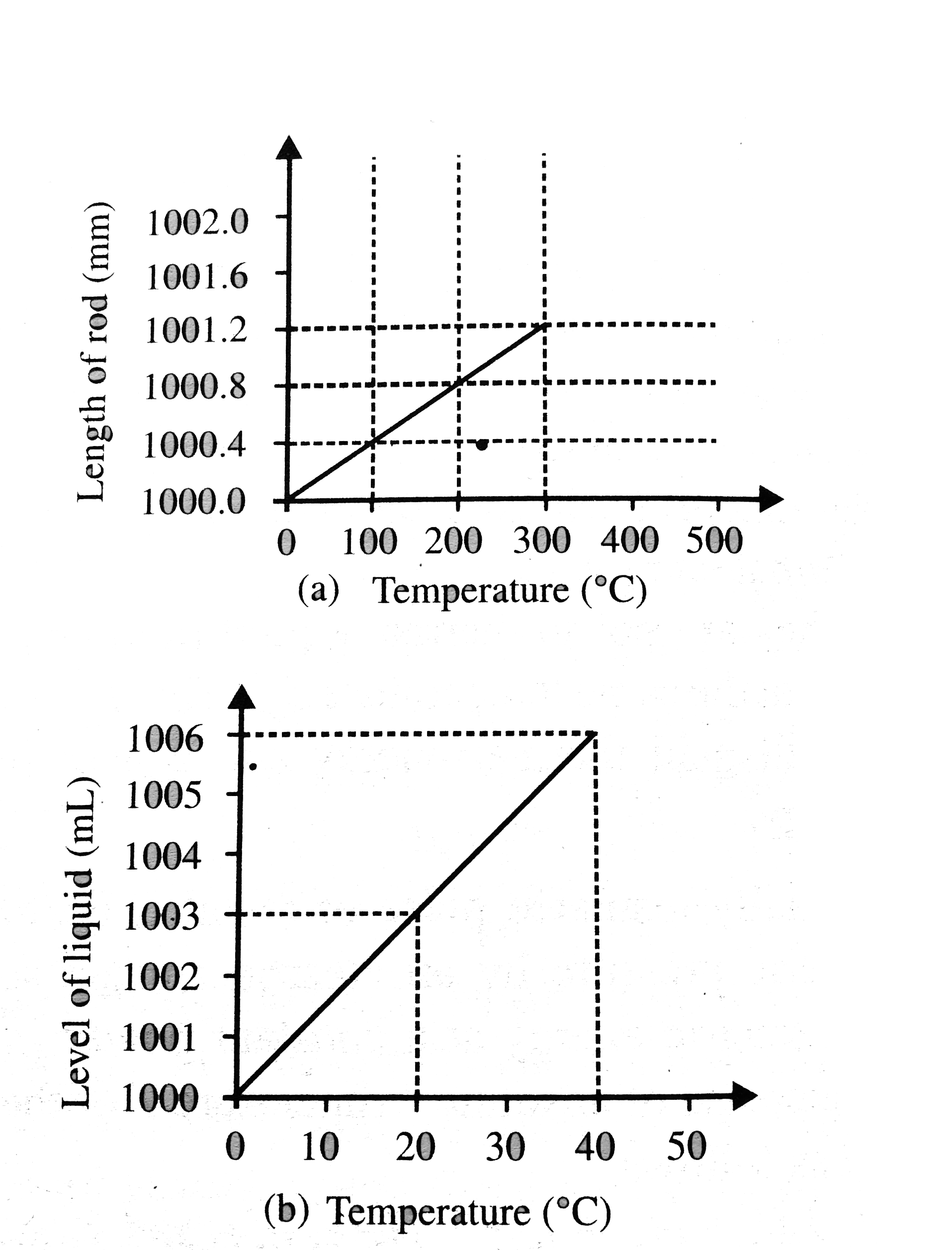
The graph of elongation of rod of a substance A with temperature rise is shown if Fig. A liquid B contained in a cylindrical cessel made up of substance A, graduated in millilitres at 0∘C is heated gradually. The readings of the liquid level in the vessel corresponding to different temperatures are shown in the figure. the real volume expansivity of liquid isView SolutionQuestion 174
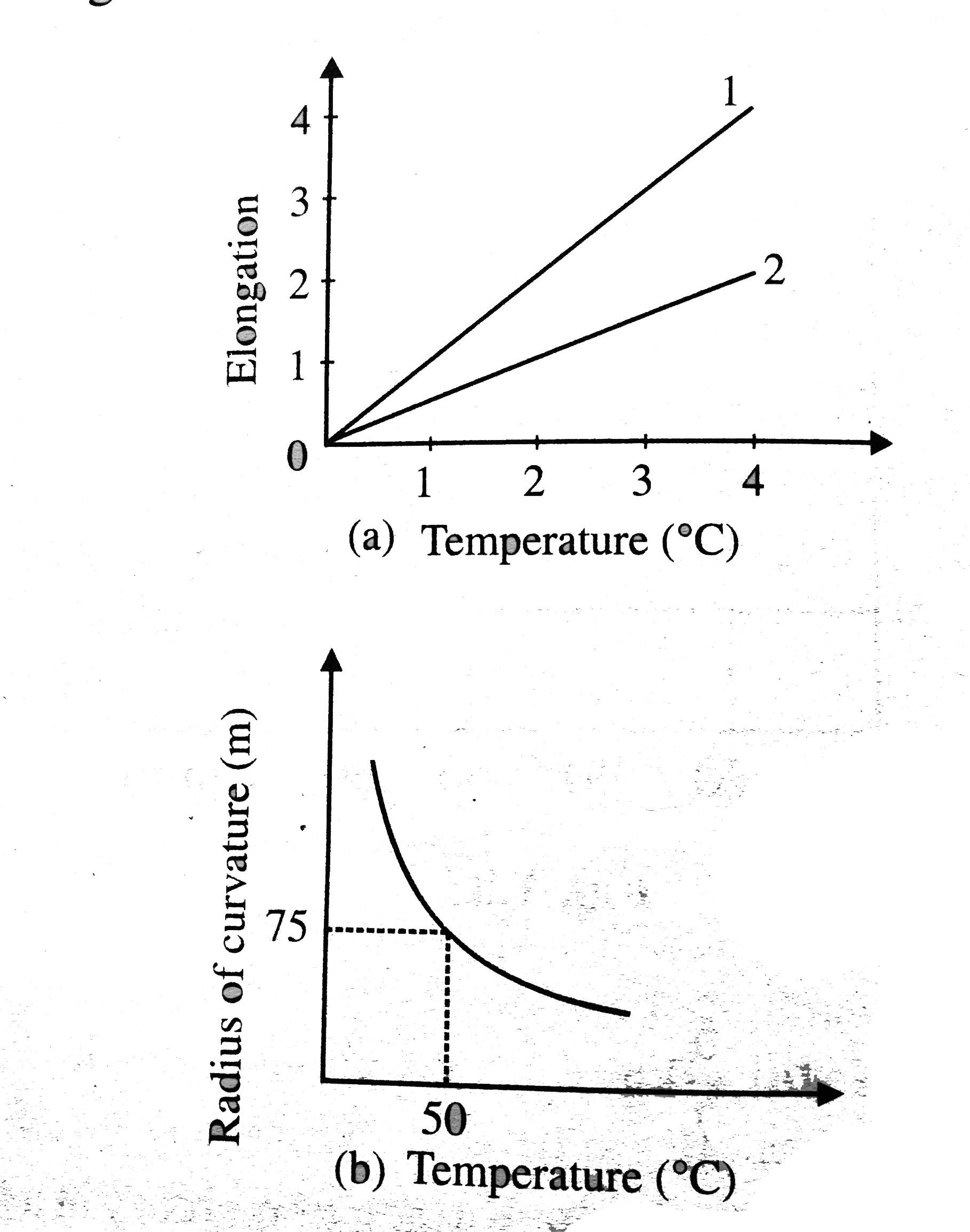
Figure. Shows the graphs of elongation versus temperature for two different metals. If these metals are employed to form a straight bimetallic strip of thickness 6 cm and heated, it bends in the form of an arc, the radius of cuvature chaging with temperature approximately as shown in the figure. The linear expansivities of the two metals areView SolutionQuestion 176
A system receives heat continuously at the rate of 10 W. The temperature of the system becomes constant at 70∘C when the temperature of the surroundings is 30∘C. After the heater is switched off, the system cools from 50∘C to 49.9∘C in 1 min. The heat capacity of the system is View SolutionQuestion 180
A piece of metal floats on mercury. The coefficients of volume expansion of the metal and mercury are γ1 and γ2 respectively. If the temperatures of both mercury and the metal are increased by an amount ΔT, the fraction of the volume of the metal submerged in mercury changes by the factor............View SolutionQuestion 181
A uniform brass disc of radius a and mass m is set into spinning with angular speed ω0 about an axis passing through centre of disc and perpendicular to the palne of disc. If its temperature increases from θ∘1C to θ∘2C with out disturbing the disc, what will be its new angular speed ?View SolutionQuestion 182
Calculate the compressional force required to prevent the metallic rod of length l cm and cross sectional area Acm2 when heated through t∘C from expanding lengthwise. Young's modulus of elasticity of the metal is E and mean coefficient of linear expansion is α per degree celsius.View SolutionQuestion 183
The coefficient of linear expansion of glass is αg per .∘C and the cubical expansion of mercury is λm per .∘C. The volume of the bulb of a mercury thermometer at 0∘C is V0 and cross section of the capillary is A0. What is the length of mercury column in capillary at T∘C, if the mercury just fills the bulb at 0∘C ?View SolutionQuestion 184
A 10kW drilling machine is used to drill a bore in a small aluminium block of mass 8.0kg. How much is the rise in temperature of the block in 2.5 minutes, assuming 50% of power is used up in heating the machine itself or lost to the surrounding? Specific heat of aluminium =0.91J/g∘C.View SolutionQuestion 185
A ball of thremal capacity 10cal/∘C is heated to the temperature of furnace it is then transferred into a vessel containing water. The water equivalent of vessel and the constents is 200 g. The temperature of the vessel and its contents rises from 10∘C to 40∘C. What is the temperature of furnace?View SolutionQuestion 188
Ice at 0∘C is added to 200 g of water initially at 70∘C in a vacuum flask. When 50 g of ice has been added and has all melted the temperature of the flask and contents is 40∘C. When a further 80 g of ice has been added and has all melted the temperature of the whole becomes 10∘C. Find the latent heat of fusion of ice. View SolutionQuestion 194
One end of a copper rod of uniform cross section and length 1.5 m is kept in contact with ice and the other end with water at 100∘C. At what point along its length should a temperature of 200∘C be maintained so that in the steady state, the mass of ice melting be equal to that of the steam produced in same interval of time. Assume that the whole system is insulated from surroundings:
[Lice=80cal/g,Lsteam=540cal/g]View SolutionQuestion 196
A 1-L flask contains some mercury. It is found that at different temperature, the volume of air inside the flask remains the same. What is the volume of mercury in the flask, given that the coefficient of linear expansion of glass=9×10−6/∘C and the coefficient of volume expansion of Hg=1.8×10−4/∘C ?View SolutionQuestion 201
The earth receives at its surface radiation from the sun at the rate of 1400Wm−2. The distance of the centre of the sun from the surface of the earth is 1.5×1011m and the radius of the sun is 7×108m. Treating the sun as a black body, it follows from the above data that its surface temperature is ......KView SolutionQuestion 202

Three rods of identical cross-sectional area and made from the same metal form the sides of an isosceles Delta ABC right angled at B. The points A and B are maintained at temperetures T and √2T, respectively in the steady state. Assuming that only heat conduction takes place, temperature of point C is View SolutionQuestion 205
An iron rod of length 50 cm is joined at an end to aluminium rod of length 100 cm. All measurements refer to 20_0 C . Find the length of the composite system at 1000 C. and its average coefficent of linear expansion. The coefficient o f linear expansion o f iron and aluminium are 10 xx 10_-6 0 C_-1 and 24 xx10_-6 0 C _-1 respectively.View SolutionQuestion 211
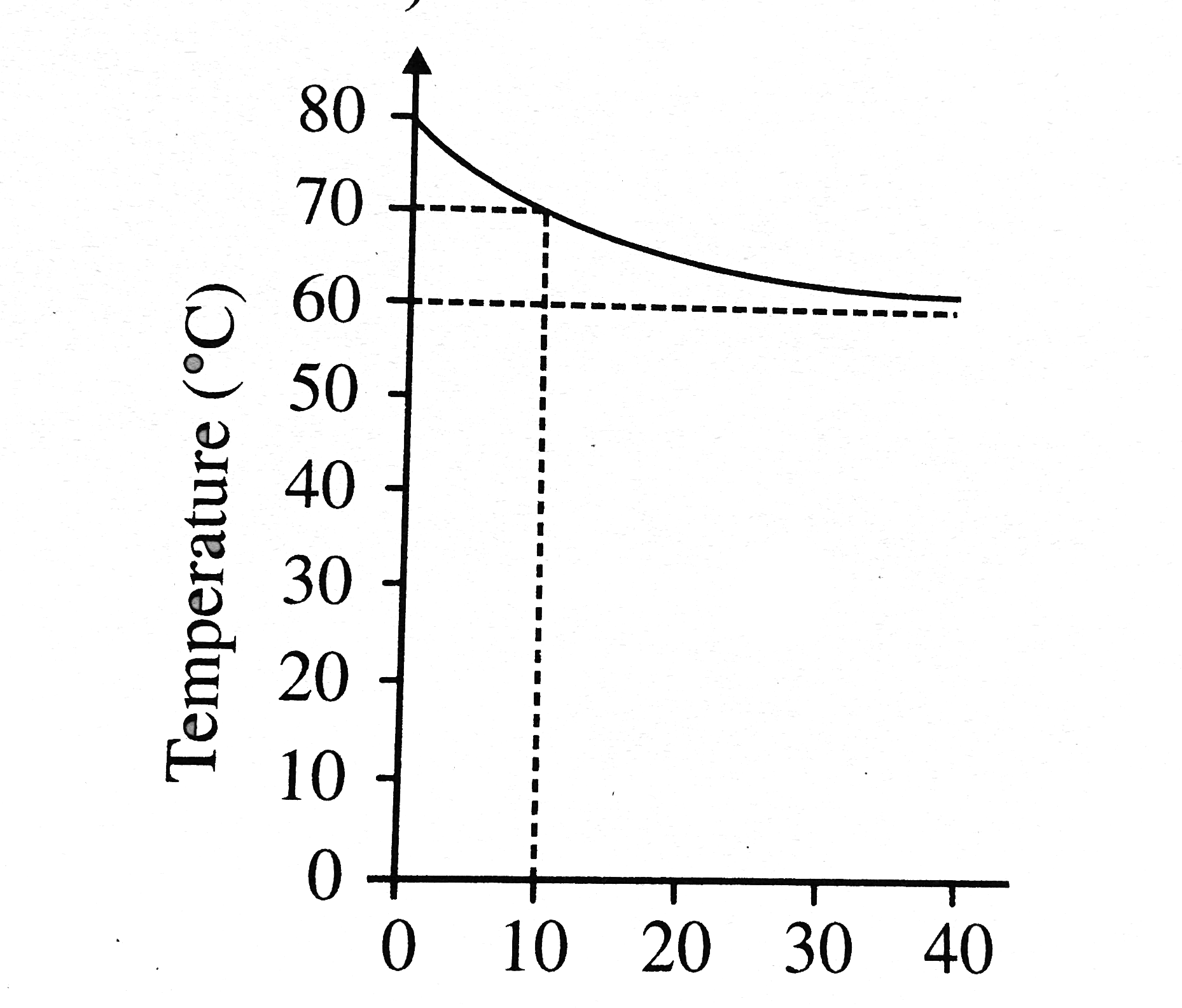
A vessel contains M grams of water at a certain temperature and water at certain other temperature is passed into it at a constant rate of mg/s. The variation of temeprature of the mixture with time is shown in Fig. The values of M and m are, respectively (the heat exhanged after a long time is 800 cal)View SolutionQuestion 212
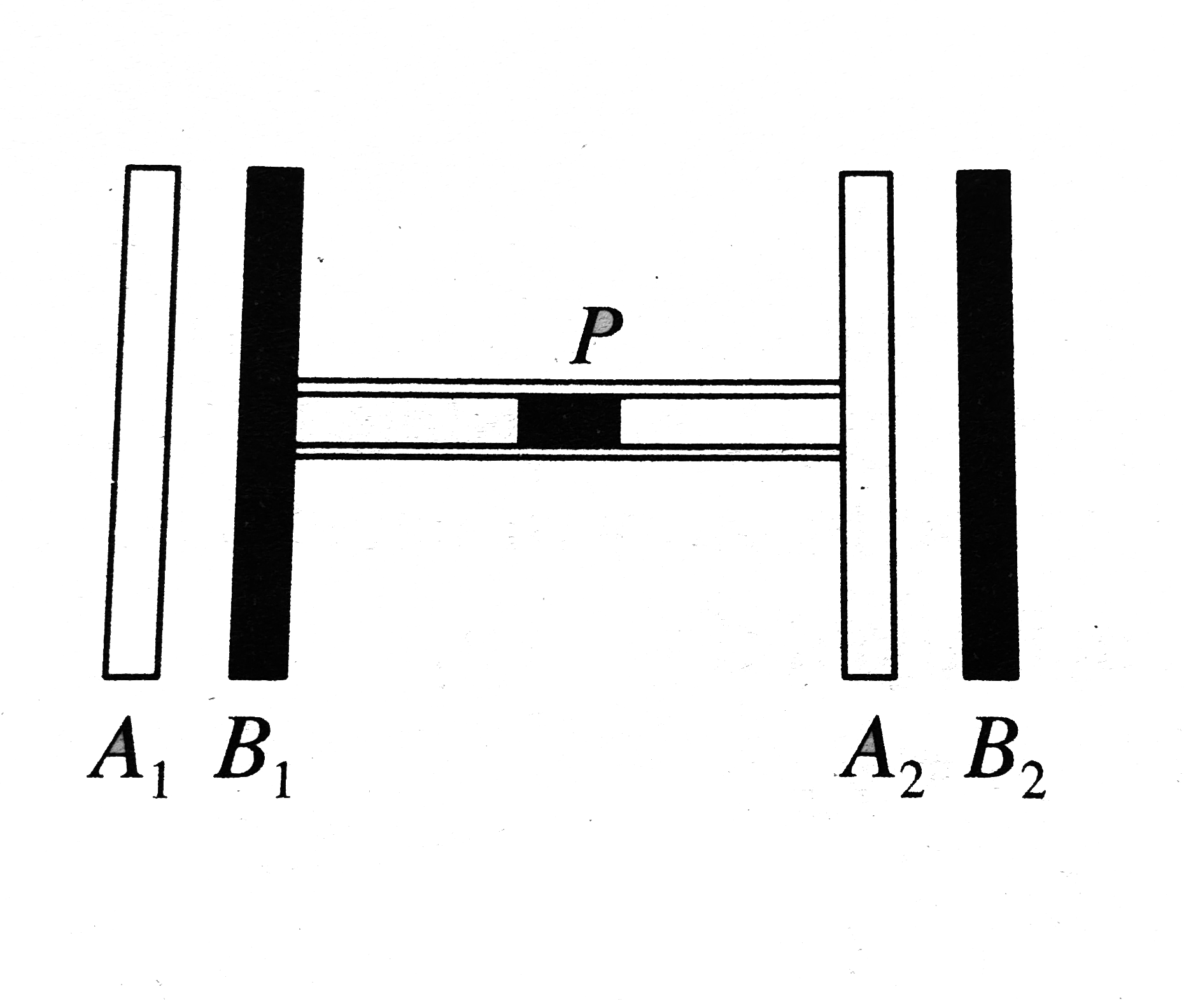
Two plates identical in size, one of black and rough surface (B1) and the other smooth and polished (A2) are in terconnected by a thin horizontal pipe with a mercury pellet at the centre. Two more plates A1 (identical to A2) and B2 (identical B1) are heated to the same temperature and placed closed to the plates B1, and A2 shown in Fig. The mercury pelletView SolutionQuestion 213
Two spheres of different materials one with double the radius and one-fourth wall thickness of the other are filled with ice. If the time taken for complete melting of ice in the larger sphere is 25 minutes and for smaller one is 16 minutes, the ratio of thermal conductivities of the materials of larger sphere to that of smaller sphere is:View SolutionQuestion 215
An earthen pitcher loses 1 g of water per minute due to evaporation. If the water equivalent of pitcher is 0.5 kg and the pitcher contains 9.5 kg of water, calculate the time required for the water in the pitcher to cool to 28∘C from its original temperature of 30∘C Neglect radiation effect. Latent heat of vapourization of water in this range of temperature is 580 cal/g and specific heat of water is 1kcal/gC∘View SolutionQuestion 218
A room at 20∘C is heated by a heater of resistence 20 ohm connected to 200 VV mains. The temperature is uniform throughout the room and the heati s transmitted through a glass window of area 1m2 and thickness 0.2 cm. Calculate the temperature outside. Thermal conductivity of glass is 0.2cal/mC∘ s and mechanical equivalent of heat is 4.2J/cal.View SolutionQuestion 220
One end of a copper rod of uniform cross section and length 1.5 m is kept in contact with ice and the other end with water at 100∘C. At what point along its length should a temperature of 200∘C be maintained so that in the steady state, the mass of ice melting be equal to that of the steam produced in same interval of time. Assume that the whole system is insulated from surroundings:
[Lice=80cal/g,Lsteam=540cal/g]View SolutionQuestion 229
A bar measured with a vernier caliper is found to be 180 mm long. The temperature during the measurement is 10∘C. The measurement error will be if the scale of the vernier caliper has been graduated at a temeprature of 20∘C. (α=1.1×10−5.∘C−1. Assume that the length of the bar does not change.)View SolutionQuestion 230
A closed cubical box is made of perfectly insulating material and the only way for heat to enter or leave the box is through two solid cylindrical metal plugs, each of cross sectional area 12cm2 and length 8cm fixed in the opposite walls of the box. The outer surface of one plug is kept at a temperature of 100∘C . while the outer surface of the plug is maintained at a temperature of 4(∘)C . The thermal conductivity of the material of the plug is 2.0Wm−1.∘C−1 . A source of energy generating 13W is enclosed inside the box. Find the equilibrium temperature of the inner surface of the box assuming that it is the same at all points on the inner surface.View SolutionQuestion 231
Two models of a windowpane are made. In one model, two identical glass panes of thickness 3 mm are separated with an air gap of 3 mm. This composite system is fixed in the window of a room The other model consist of a single glass pane of thickness 3 mm, the temperature difference being the same as for the first model. the ratio of the heat flow fot the double pane to that for the single pane is
(Kglass=2.5×10−4cal/s.m.∘C and Kair=6.2×10−6cal/s.m.∘C).View SolutionQuestion 234
Water at 0∘C was heated until it started to boil and then until it all changed to steam. The time required to heat water from 0∘C to 100∘C is 5 min and the time to change boiling water to steam is 28 minutes. If the flame supplied heat at a constant rate, the specific latent heat of vaporisation of water (neglecting heat losses, container etc. is (in J/g). (specific heat of water s =4.2J/g )View SolutionQuestion 248
A vessel is partly filled with liquid. When the vessel is cooled to a lower temperature, the space in the vessel unoccupied by the liquid remains constant. Then the volume of the liquid (VL) volume of the vessel (VV) the coefficient of cubical expansion of the material of the vessel (γv) and of the solid (γL) are related asView SolutionQuestion 249
Two identical objects A and B are at temperatures TA and TB. Respectively. Both objects are placed in a room with perfectly absorbing walls maintained at a temperature T(TA>T>TB). The objects A and B attain the temperature T eventually. Select the correct statements from the following:View SolutionQuestion 250
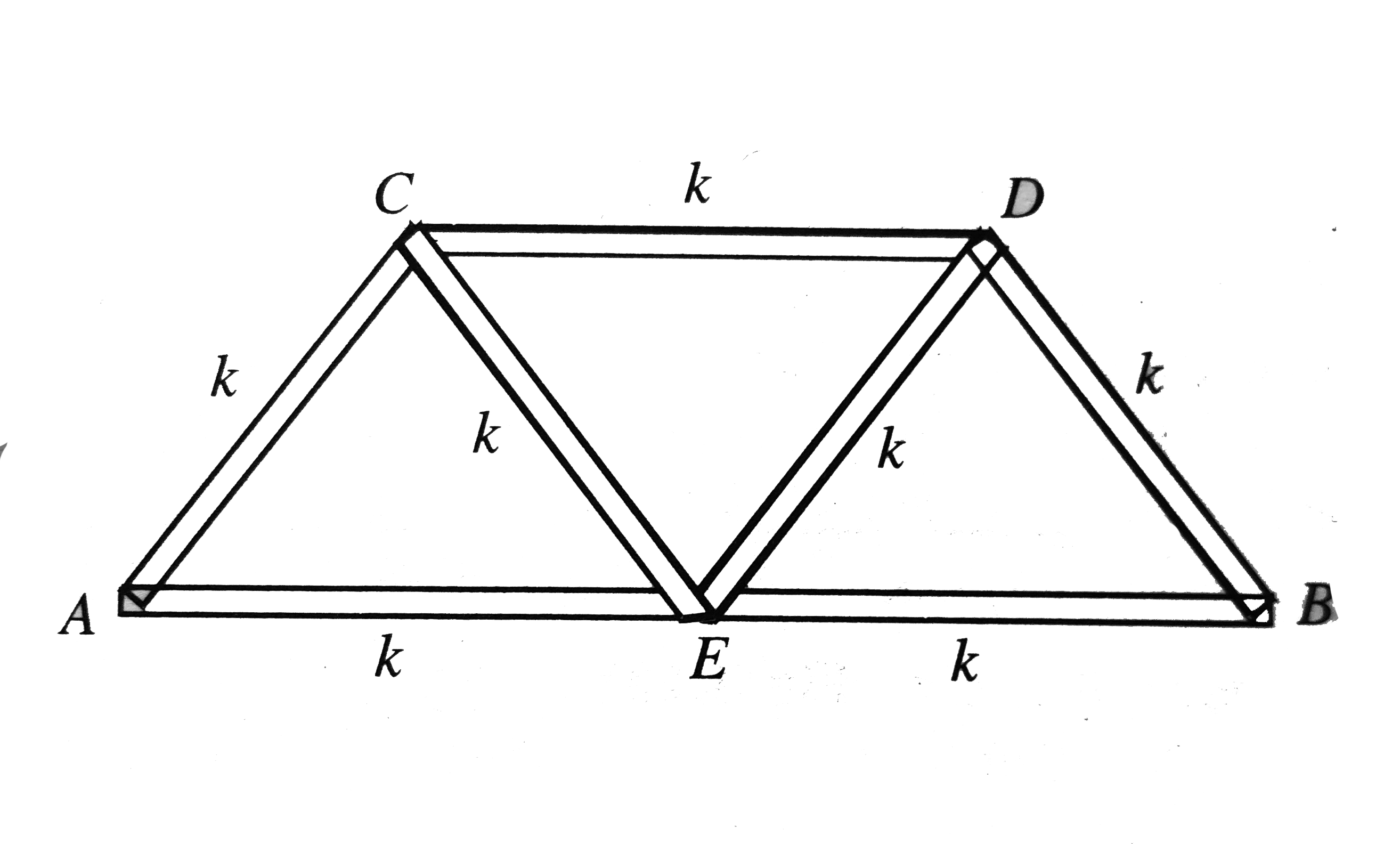
Seven identical rods of material of thermal conductivity k are connected as shown in Fig. All the rods are of identical length l and cross sectional area A If the one end B is kept at 100∘C and the other end is kept at 0∘C what would be the temperatures of the junctions C, D and E(θC,θ)D and θE) in the steady state?View SolutionQuestion 252
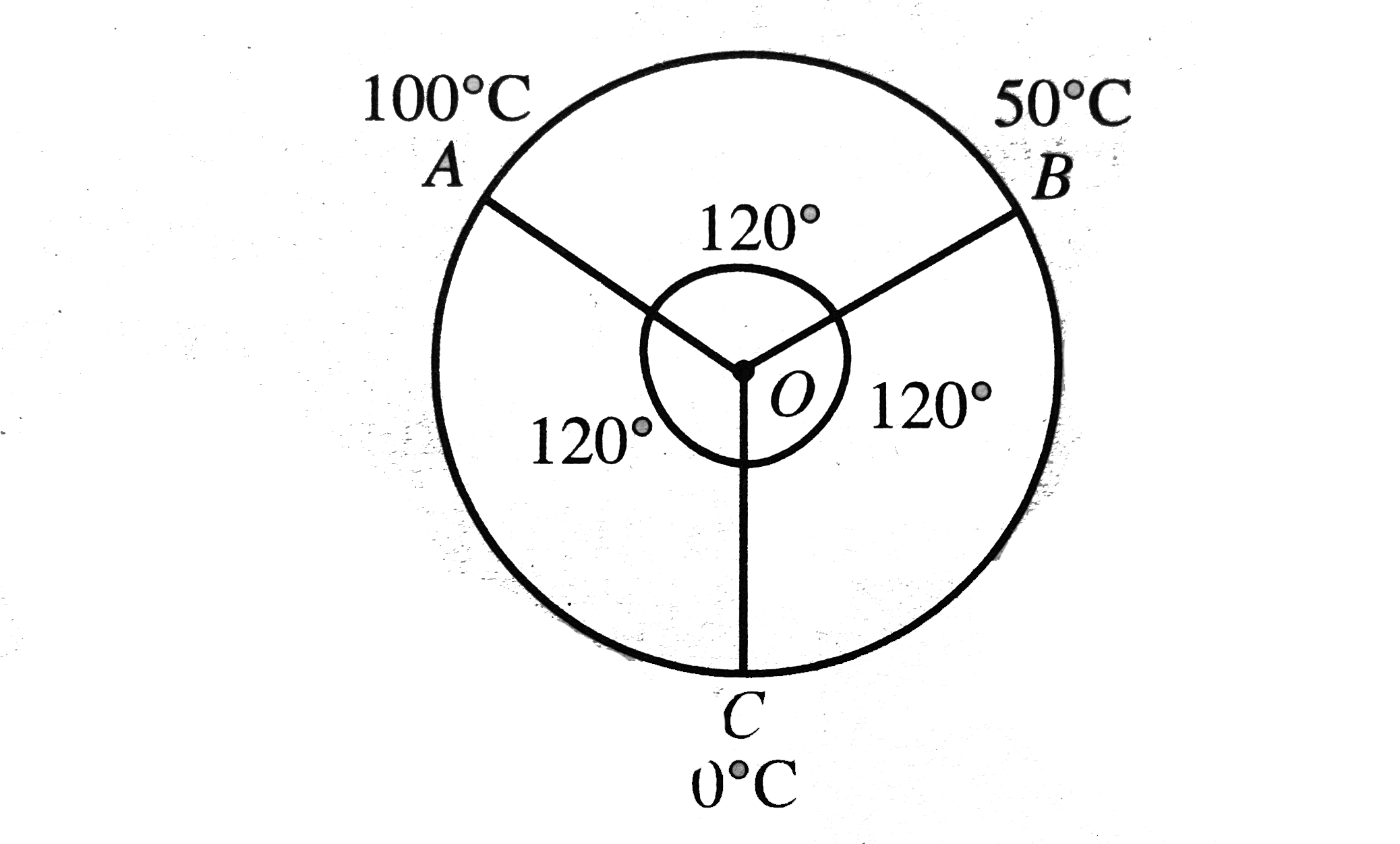
A circular ring (centre O) of radius a, and of uniform cross section is made up of three different metallic rods AB, BC and CA (joined together at the points A, B and C in pairs) of thermal conductivityies α1,α2 and α3 respectively (see diagram). The junction A, B and C are maintained at the temperatures 100∘C,50∘C and 0∘C, respectively. All the rods are of equal lengths and cross sections. Under steady state conditions, assume that no heat is lost from the sides of the rods. Let Q1,Q2 and Q3 be the rates of transmission of heat along the three rods AB, BC and CA. ThenView SolutionQuestion 253
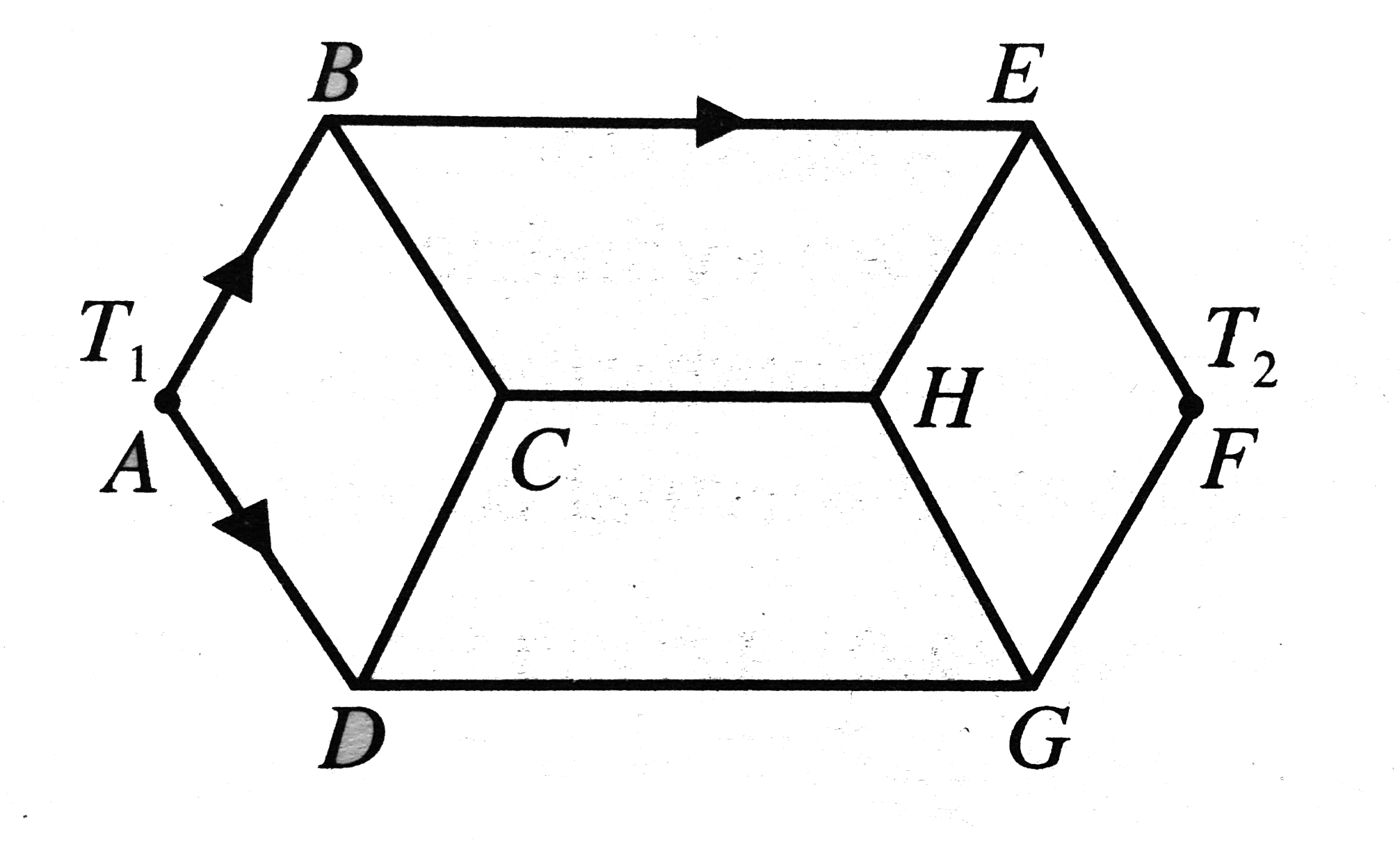
Eleven identical rods are arranged as shown in Fig. Each rod has length l, cross sectional area A and thermal conductivity of material L. Ends A and F are maintained at temperatures T1 and T2(<T1), respectively. If lateral surface of each rod is thermally insulated, the rate of heat transfer (dQdt) in each rod isView SolutionQuestion 256
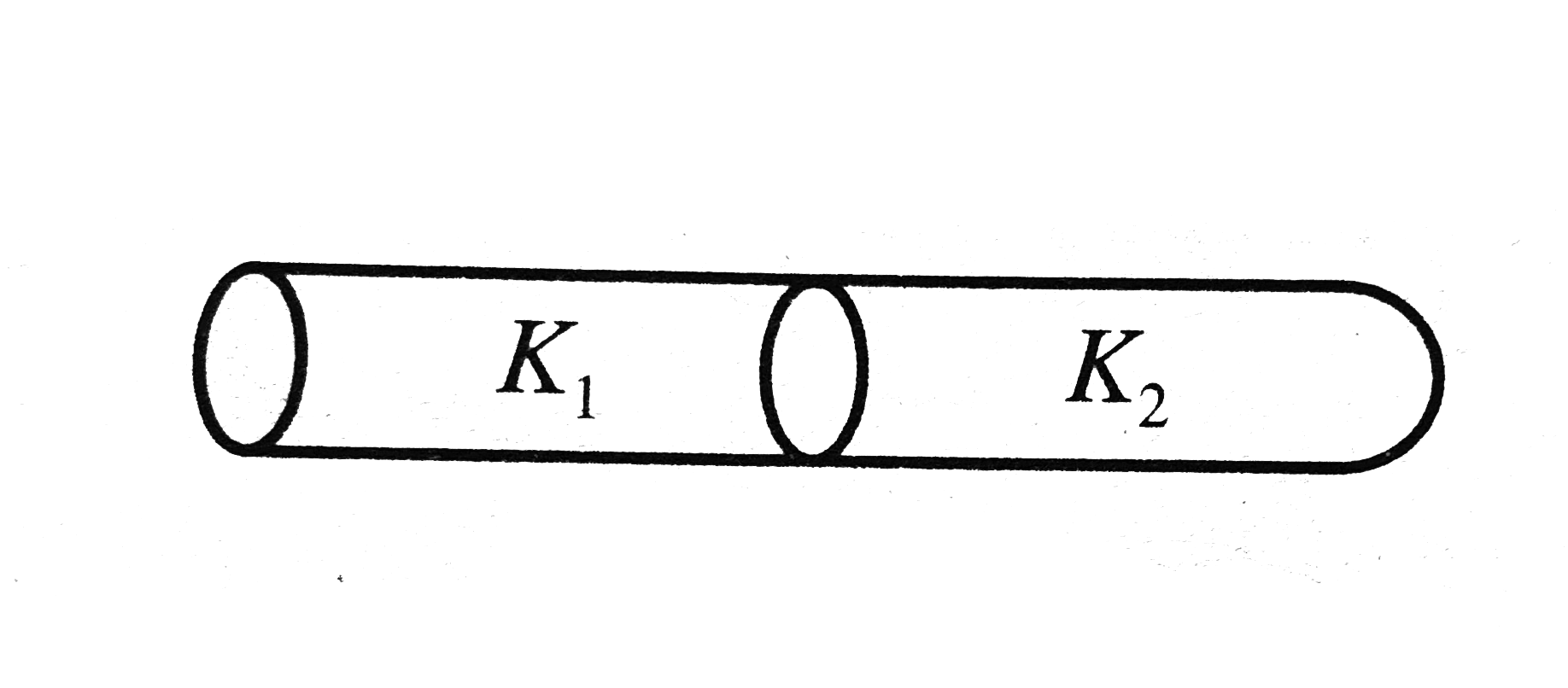 Statement I: Two solid cylindrical rods of identical size and different thermal conductivity K1 and K2 are connected in series. Then the equivalent thermal conductivity of two rods system is less than that value of thermal conductivity of either rod.
Statement I: Two solid cylindrical rods of identical size and different thermal conductivity K1 and K2 are connected in series. Then the equivalent thermal conductivity of two rods system is less than that value of thermal conductivity of either rod.
Statement II: For two cylindrical rods of identical size and different thermal conductivity K1 and K2 connected in series, the equivalent thermal conductivity K is given by 2K=1K1+1K2View SolutionQuestion 257
Statement I: As the temperature of the black body increases, the wavelength at which the spectral intensity (Eλ) is maximum decreases.
Statement II: The wavelength at which the spectral intensity will be maximum for a black body is proportional to the fourth power of its absolute temperature.View SolutionQuestion 260
Statement I: The bulb of one thermometer is spherical while that of the other is cylindrical . Both have equal amounts of mercury. The response of the cylindrical bulb thermometer will be quicker.
Statement II: Heat conduction in a body is directly proportional to cross-sectional area.View SolutionQuestion 261
Statement I: The expanded length l of a rod of original length l0 is not correctly given by (assuming α to be constant with T) l=l0(1+αΔT) if αΔT is large.
Statement II: It is given by l=l0eαΔT, which cannot be treated as being approximately equal to l=l0(1+αΔT) for large value a ΔT.View SolutionQuestion 264
A body cools in a surrounding of constant temperature 30∘C Its heat capacity is 2J/∘C. Initial temeprature of cooling is valid. The body cools to 38∘C in 10 min
When the body temperature has reached 38∘C, it is heated again so that it reches 40∘C in 10 min. The heat required from a heater by the body is View SolutionQuestion 265
The inernal energy of a solid also increases when heat is transferred to it from its surroundings. A 5 kg solid bar is heated at atmospheric pressure. Its temperature increases from 20∘C to 70∘C. The linear expansion coefficient of solid bar is 1×10−3/∘C. The density of solid bar is 50kg/m3. The specific heat capacity of solid bar is 200J/kgC∘. The atmospheric pressure is 1×10N/m2.
The work done by the solid bar due to thermal expansion, under atmospheric pressure isView SolutionQuestion 266
The inernal energy of a solid also increases when heat is transferred to it from its surroundings. A 5 kg solid bar is heated at atmospheric pressure. Its temperature increases from 20∘C to 70∘C. The linear expansion coefficient of solid bar is 1×10−3/∘C. The density of solid bar is 50kg/m3. The specific heat capacity of solid bar is 200J/kgC∘. The atmospheric pressure is 1×10N/m2.
The heat transferred to the solid bar is View SolutionQuestion 267
The inernal energy of a solid also increases when heat is transferred to it from its surroundings. A 5 kg solid bar is heated at atmospheric pressure. Its temperature increases from 20∘C to 70∘C. The linear expansion coefficient of solid bar is 1×10−3/∘C. The density of solid bar is 50Kg/m3. The specific heat capacity of solid bar is 200J/kgC∘. The atmospheric pressure is 1×10N/m2.
The increase in the internal energy of the sold bar is View SolutionQuestion 268
A wire of length 1 m and radius 10−3m is carrying a heavy current and is assumed to radiate as a black body. At equilibrium, its temperature is 900 K while that of surrounding is 300 K. The resistivity of the material of the wire at 300 K is π∘×10−8 ohm m and its temperature coefficient of resistance is 7.8×10−3/C (stefan's constantσ=5.68×10−8W/m2K4).
Q. The resistivity of wire at 900 K is nearlyView SolutionQuestion 269
A wire of length 1 m and radius 10−3m is carrying a heavy current and is assumed to radiate as a black body. At equilibrium, its temperature is 900 K while that of surrounding is 300 K. The resistivity of the material of the wire at 300 K is π∘×10−8 ohm m and its temperature coefficient of resistance is 7.8×10−3/C (stefan's constantσ=5.68×10−8W/m2K2.
Heat radiated per second by the wire is nearlyView SolutionQuestion 270
A wire of length 1 m and radius 10−3m is carrying a heavy current and is assumed to radiate as a black body. At equilibrium, its temperature is 900 K while that of surrounding is 300 K. The resistivity of the material of the wire at 300 K is π∘×10−8 ohm m and its temperature coefficient of resistance is 7.8×10−3/C (stefan's constantσ=5.68×10−8W/m2K2.
The current in the wire is nearlyView SolutionQuestion 271
Assume that the thermal conductivity of copper is twice that of aluminium and four times that of brass. Three metal rods made of copper, aluminium and brass are each 15 cm long and 2 cm in diameter. These rods are placed end to end, with aluminium between the other two. The free ends of the copper and brass rods are maintained at 100∘C and 0∘C respectively. The system is allowed to reach the steady state condition. Assume there is no loss of heat anywhere.
When steady state condition is reached everywhere, which of the following statement is true?View SolutionQuestion 272
Assume that the thermal conductivity of copper is twice that of aluminium and four times that of brass. Three metal rods made of copper, aluminium and brass are each 15 cm long and 2 cm in diameter. These rods are placed end to end, with aluminium between the other two. The free ends of the copper and brass rods are maintained at 100∘C and 0∘C respectively. The system is allowed to reach the steady state condition. Assume there is no loss of heat anywhere.
Under steady state condition the equilibrium temperature of the copper aluminium junction will beView SolutionQuestion 273
Assume that the thermal conductivity of copper is twice that of aluminium and four times that of brass. Three metal rods made of copper, aluminium and brass are each 15 cm long and 2 cm in diameter. These rods are placed end to end, with aluminium between the other two. The free ends of the copper and brass rods are maintained at 100∘C and 0∘C respectively. The system is allowed to reach the steady state condition. Assume there is no loss of heat anywhere.
Under steady state condition the equilibrium temperature of the copper aluminium junction will beView SolutionQuestion 274
A thin copper rod of uniform cross section A square metres and of length L metres has a spherical metal sphere of radius r metre at tis one end symmetrically attached to the copper rod. The thermal conductivity of copper is K and the emissivity of the spherical surface of the sphere is ε.The free end of the copper rod is maintained at the temperature T kelving by supplying thermal energy from a P watt source. Steady state conditions are allowed ot be established while the rod is properly insulated aginst heat loss from its lateral surface. Surroundings are at 0∘C Stefan's constant=σW/m2K4.
After the steady state conditions are reached,the temperature of the spherical end of the rod, TS is View SolutionQuestion 275
A thin copper rod of uniform cross section A square metres and of length L metres has a spherical metal sphere of radius r metre at tis one end symmetrically attached to the copper rod. The thermal conductivity of copper is K and the emissivity of the spherical surface of the sphere is ε.The free end of the copper rod is maintained at the temperature T kelving by supplying thermal energy from a P watt source. Steady state conditions are allowed ot be established while the rod is properly insulated aginst heat loss from its lateral surface. Surroundings are at 0∘C Stefan's constant=σW/m2K4.
The net power that will be radiated out, PS from the sphere after steady state condition are reached is View SolutionQuestion 276
A thin copper rod of uniform cross section A square metres and of length L metres has a spherical metal sphere of radius r metre at tis one end symmetrically attached to the copper rod. The thermal conductivity of copper is K and the emissivity of the spherical surface of the sphere is ε.The free end of the copper rod is maintained at the temperature T kelving by supplying thermal energy from a P watt source. Steady state conditions are allowed ot be established while the rod is properly insulated aginst heat loss from its lateral surface. Surroundings are at 0∘C Stefan's constant=σW/m2K4.
If the metal sphere attached at the end of the copper rod is made of brass, whose thermal conductivity is Kb<K, then which of the following statements is true?View SolutionQuestion 278
An immersion heater, in an insulated vessel of negligible heat capacity brings 10 g of water to the boiling point from 16∘C in 7 min. Then
Q. The water is replaced by 200 g of alcohol, which is heated from 16∘C to the boiling point of 78∘C in 6 min 12 s whereas 30 g are vapourized in 5 min 6 s. The specific heat of alcohol isView SolutionQuestion 282
A body of area 0.8×10−2m2 and mass 5×10−4kg directly faces the sun on a clear day. The body has an emissivity of 0.8 and specific heat of 0.8cal/kg K. The surroundings are at 27∘C. (solar constant=1.4kW/m2).
The temperature that the body would reach if it lost all its heat by radiation isView SolutionQuestion 283
A copper collar is to fit tightly about a steel shaft that has a diameter of 6 cm at 20∘C. The inside diameter of the copper collar at the temperature is 5.98cm
Q. To what temperature must the copper collar be raised to that it will just slip on the steel shaft, assuming the steel shaft remains at 20∘C ? (αcopper=17×10−6/K)View SolutionQuestion 287
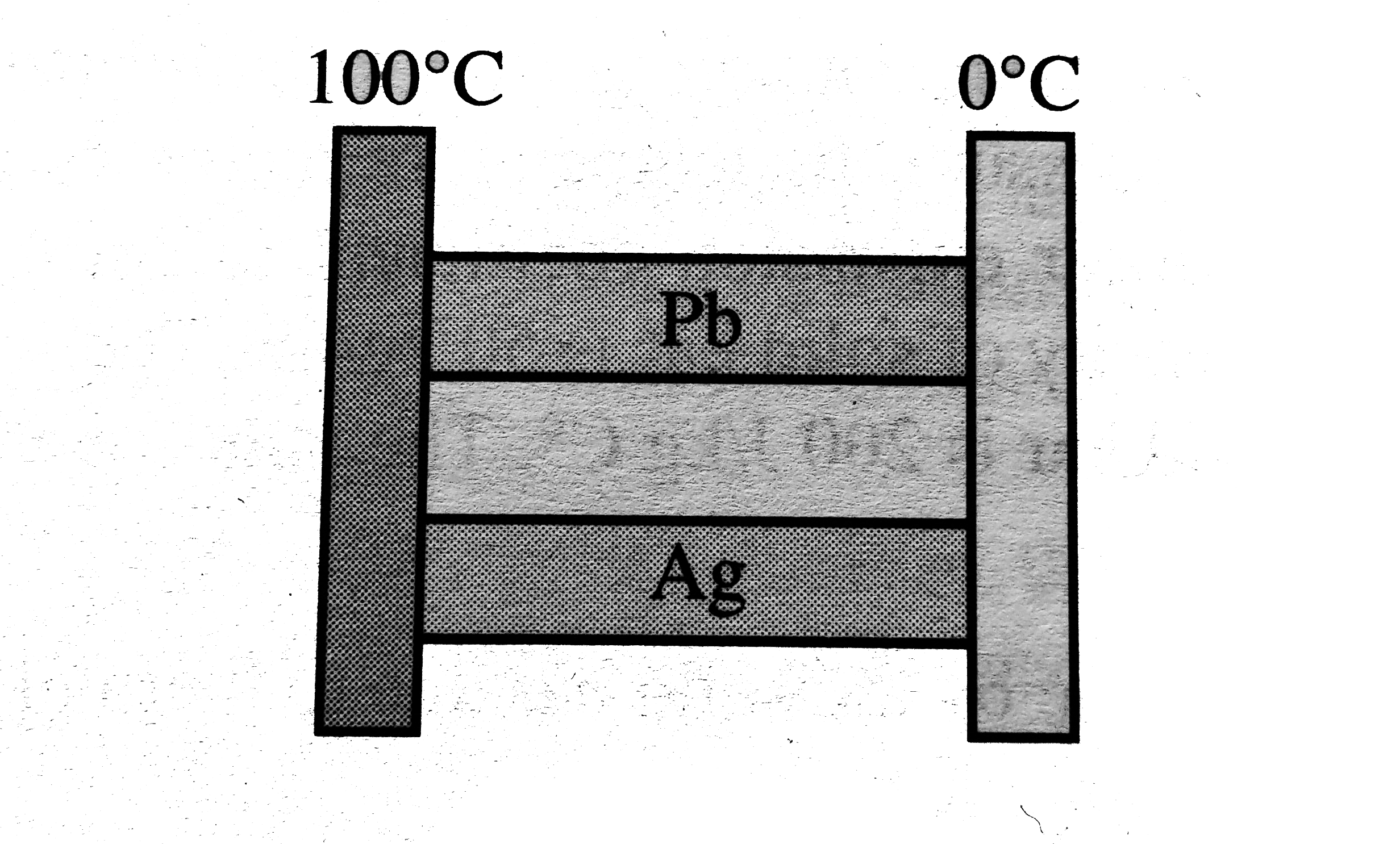
Two insulated metal bars each of length 5 cm and rectangular cross section with sides 2 cm and 3 cm are wedged between two walls, one held at 100∘C and the other at 0∘C. The bars are made of lead and silver. Kpb=350W/mK,KAg=425W/mK.
Total thermal current through the two bar system is View SolutionQuestion 288

Two insulated metal bars each of length 5 cm and rectangular cross section with sides 2 cm and 3 cm are wedged between two walls, one held at 100∘C and the other at 0∘C. The bars are made of lead and silver. Kpb=350W/mK,KAg=425W/mK.
Equevalent thermal resistence of the two bar system is View SolutionQuestion 289

A 0.60 kg sample of water and a sample of ice are placed in two compartmetnts A and B separated by a conducting wall, in a thermally insulated container. The rate of heat transfer from the water to the ice through the conducting wall is constant P, until thermal equilibrium is reached. The temperature T of the liquid water and the ice are given in graph as functions of time t. Temperature of the compartments remain homogeneous during whole heat transfer process. Given specific heat of ice =2100J/kg−K, specific heat of water =4200J/kg−K, and latent heat of fusion of ice =3.3×105J/kg.View SolutionQuestion 290
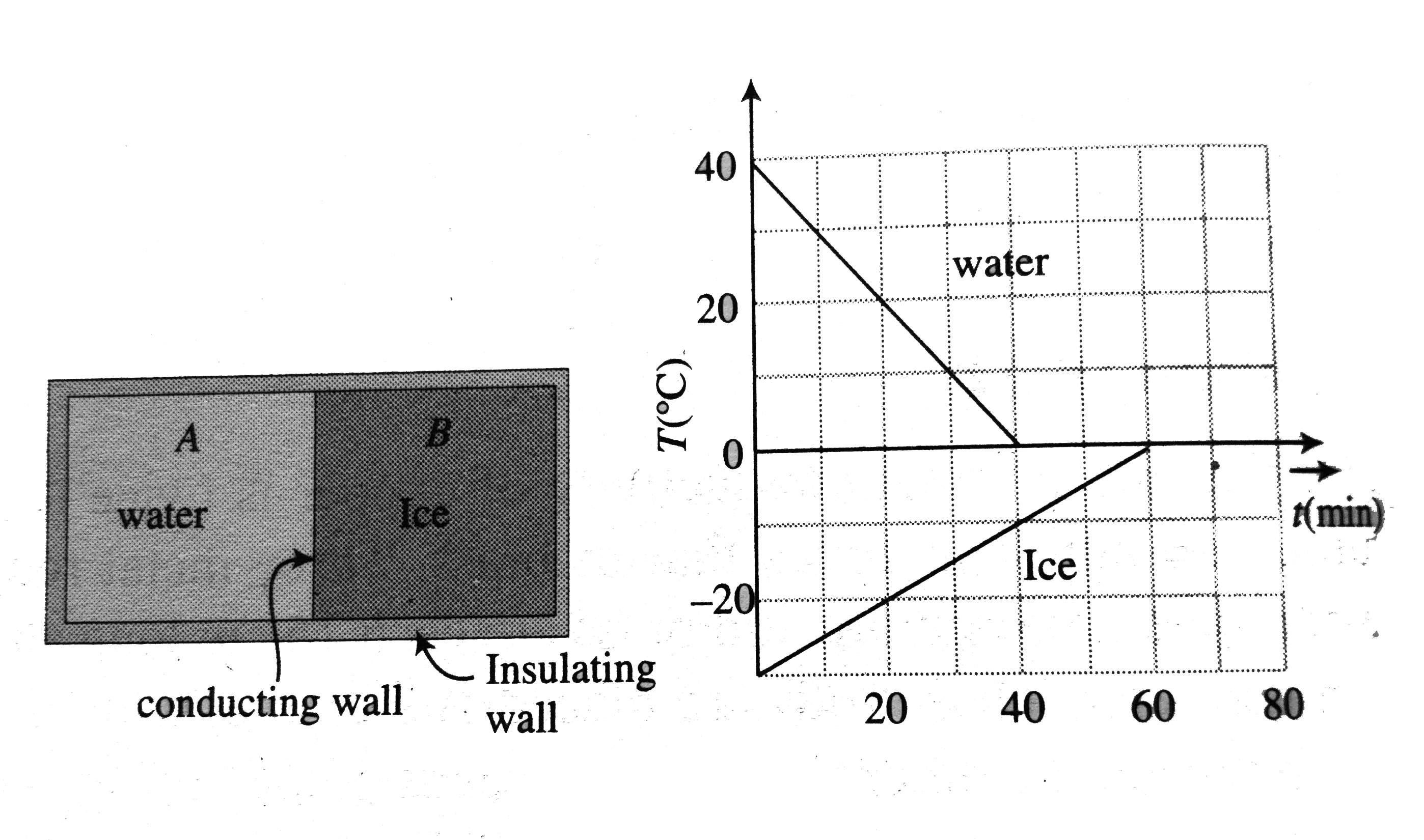
A 0.60 kg sample of water and a sample of ice are placed in two compartmetnts A and B separated by a conducting wall, in a thermally insulated container. The rate of heat transfer from the water to the ice through the conducting wall is constant P, until thermal equilibrium is reached. The temperature T of the liquid water and the ice are given in graph as functions of time t. Temperature of the compartments remain homogeneous during whole heat transfer process. Given specific heat of ice =2100J/kg−K, specific heat of water =4200J/kg−K, and latent heat of fusion of ice =3.3×105J/kg.
Initial mass of the ice in the container equal to View SolutionQuestion 291
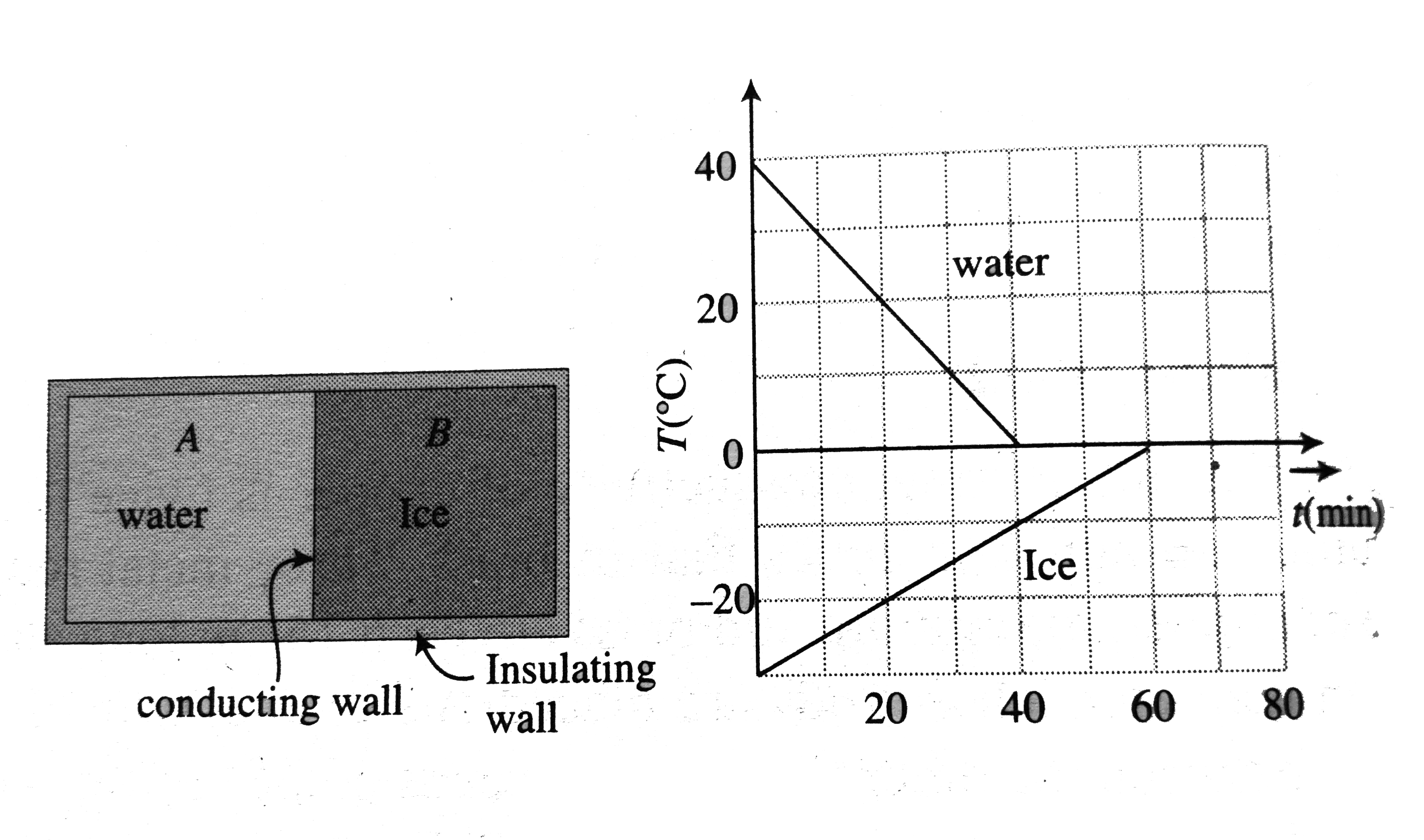
A 0.60 kg sample of water and a sample of ice are placed in two compartmetnts A and B separated by a conducting wall, in a thermally insulated container. The rate of heat transfer from the water to the ice through the conducting wall is constant P, until thermal equilibrium is reached. The temperature T of the liquid water and the ice are given in graph as functions of time t. Temperature of the compartments remain homogeneous during whole heat transfer process. Given specific heat of ice =2100J/kg−K, specific heat of water =4200J/kg−K, and latent heat of fusion of ice =3.3×105J/kg.
The mass of the ice formed due to conversion from the water till thermal equilibrium is reached is equal to View SolutionQuestion 294
In two experiments with a countinous flow calorimeter to determine the specific heat capacity of a liquid,an input power of 16 W produced a rise of 10 K in the liquid. When the power was doubled, the same temperature rise was achieved by making the rate of flow of liquid three times faster. Find the power lost (in W) to the surrounding in each case.View SolutionQuestion 298
Two identical conducting rods are first connected independently to two vessels, one containing water at 100∘C and the other containing ice at 0∘C. In the second case, the rods are joined end to end and connected to the same vessels. Let q1andq2 gram per second be the rate of melting of ice in the two cases respectively. The ratio q1q2 is
(a) 12 (b)21 (c)41 (d)14View SolutionQuestion 300
Consider a cylindrical container of cross-section area A length h and having coefficient of linear expansion αc. The container is filled by liquid of real expansion coefficient γL up to height h1. When temperature of the system is increased by Δθ then
(a). Find out the height, area and volume of cylindrical container and new volume of liquid.
(b). Find the height of liquid level when expansion of container is neglected.
(c). Find the relation between γL and αc for which volume of container above the liquid level
(i) increases
(ii). decreases
(iii). remains constant.
(d). On the surface of a cylindrical container a scale is attached for the measurement of level of liquid of liquid filled inside it. If we increase the temperature of the temperature of the system by Δθ, then
(i). Find height of liquid level as shown by the scale on the vessel. Neglect expansion of liquid.
(ii). Find the height of liquid level as shown by the scale on the vessel. Neglect expansion of container.
 View Solution
View Solution


